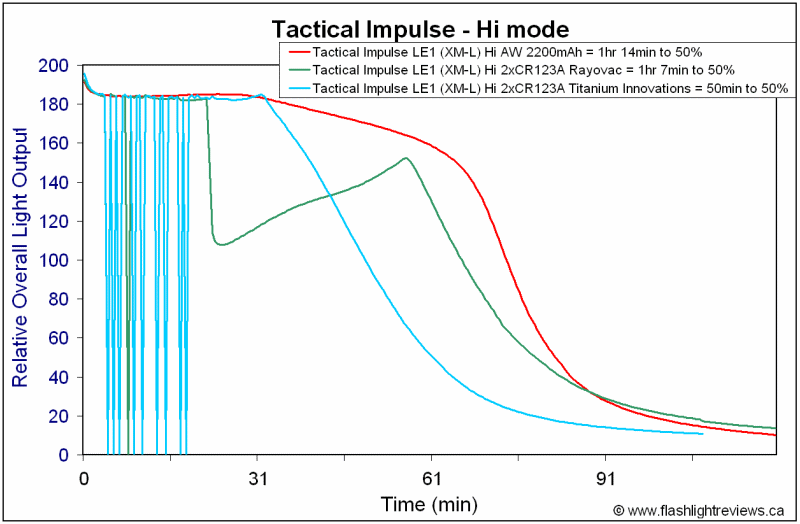Warning: a lot more pic than heavy than usual. :sweat:
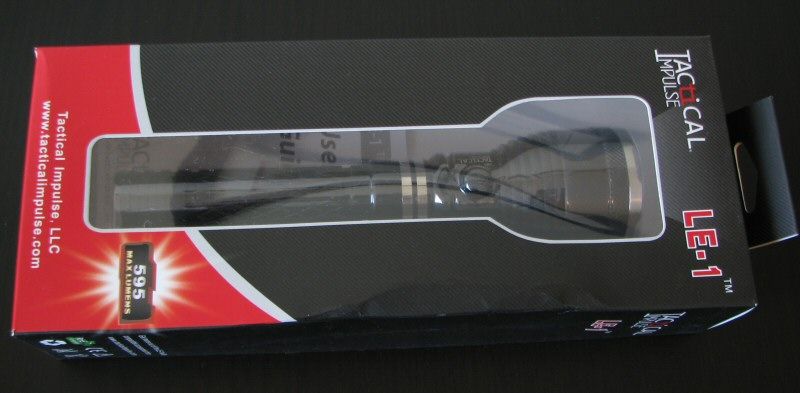
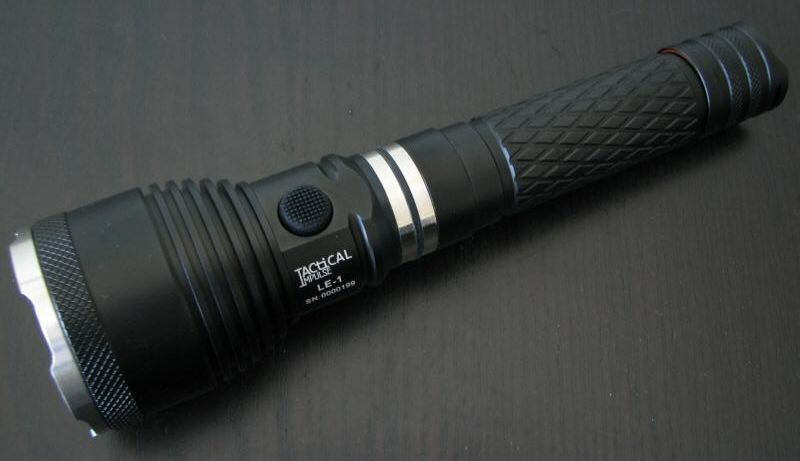
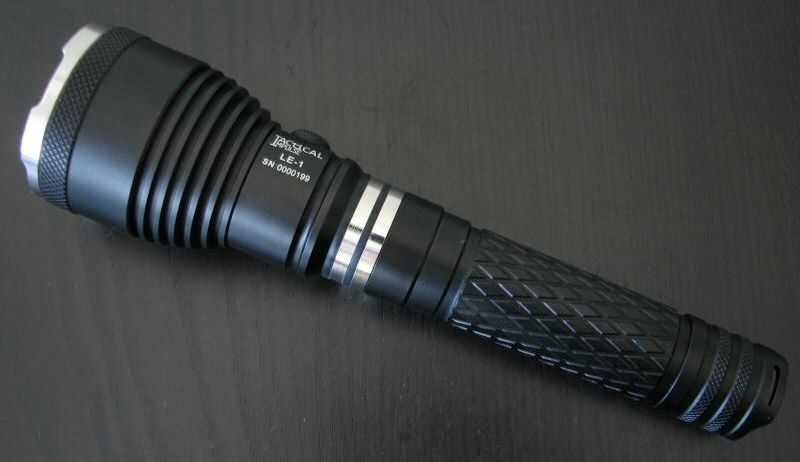
The LE-1 is the first light from Tactical Impulse, a new manufacturer geared toward law enforcement officers (LEOs) and first responders. The LE-1 comes with a wide range of accessories suited to these markets. These can purchased individually, or bought together with the light in the kit form – which I have here to review.
I will start this review with the base light, and add the additional kit accessories as we go along. This is going to be a long one, so sit back and make yourself comfy …
Manufacturer Reported Specifications:
(note: as always, these are simply what the manufacturer provides – scroll down to see my actual testing results).

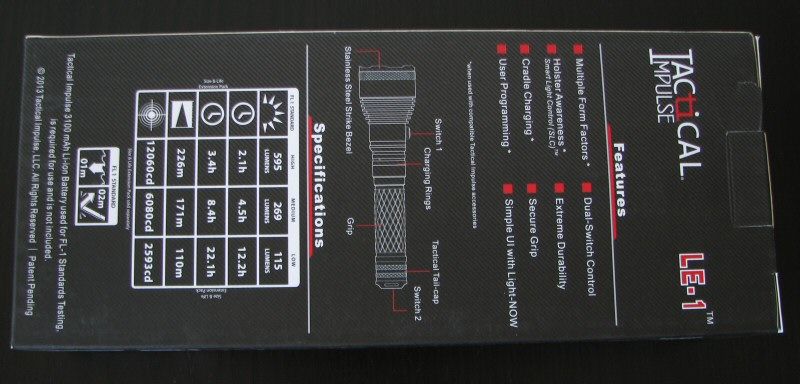
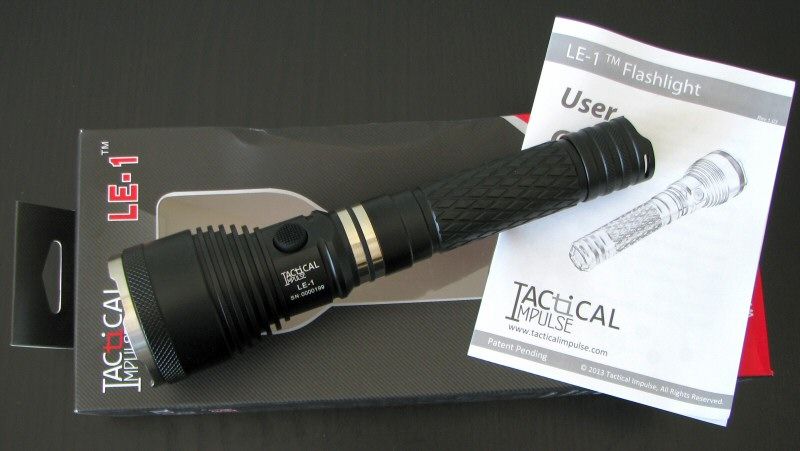
For LE-1 comes with what it promises – inside the box you get the light, a Tactical Impulse 18650 3100mAh Li-ion battery, and user guide. Oddly, there are no extra o-rings provided in the package.
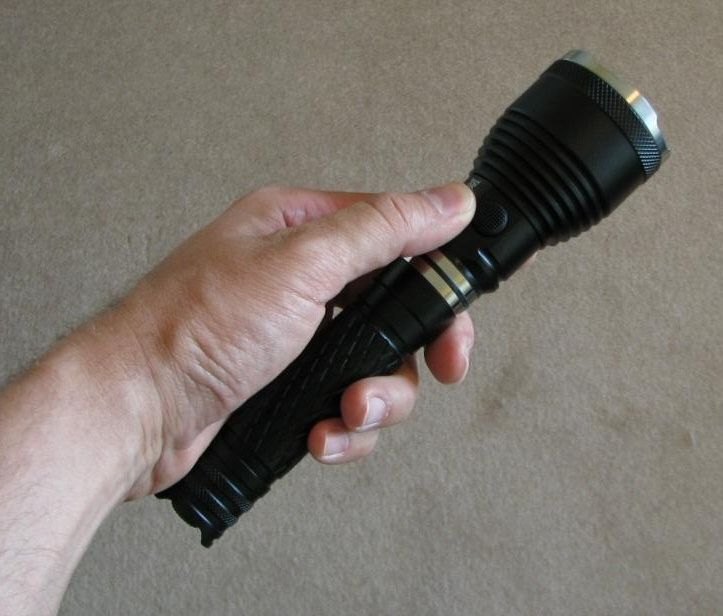
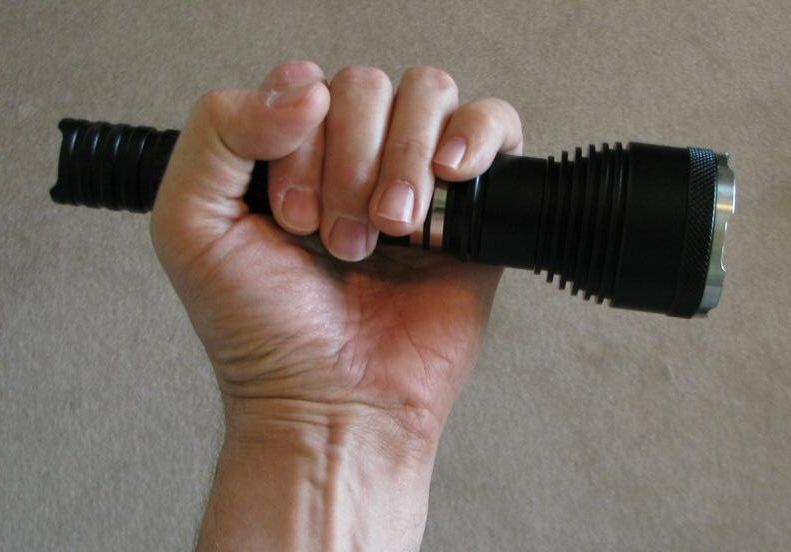
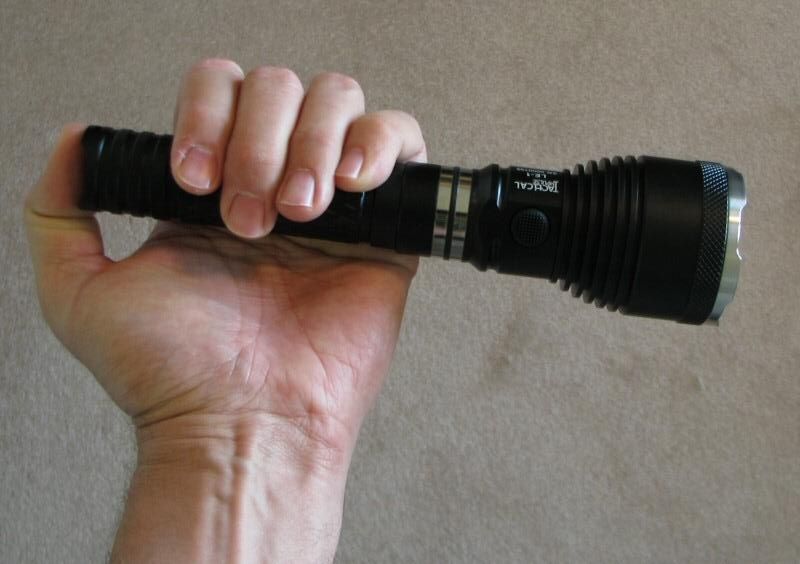
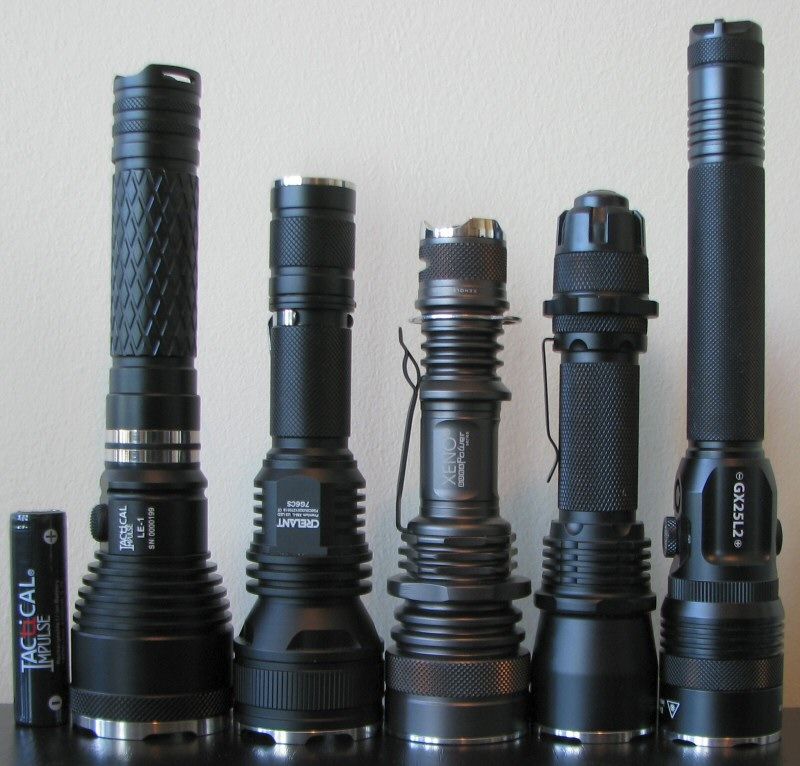
From left to right: Tactical Impulse Protected 3100mAh 18650, LE-1; Crelant 7G6CS; XENO G42; Thrunite Scorpion V2; Eagletac GX25L2.
All dimensions directly measured, and given with no batteries installed:
Tactical Impulse LE-1: Weight: 282.2g, Length: 208mm, Width (bezel): 52.0mm
ArmyTek Viking V2.5: Weight: 159.8g, Length: 153mm, Width (bezel): 39.5mm
Eagletac G25C2-II (stock): Weight 141.0g, Length: 150.6mm, Width: 39.6mm
Eagletac TX25C2: Weight 93.6g, Length: 120.4mm, Width (bezel): 31.6mm
Olight M21-X: Weight: 125.5g, Length: 144.5mm, Width: 40.3mm (head)
Olight M22: Weight: 148.4g, Length: 144.8mm, Width: 41.2mm (bezel)
Nitecore SRT7: Weight: 172.4g, Length: 158mm, Width (bezel): 40.0m
The LE-1 is longer and heavier than your typical 1x18650 tactical flashlight. The reasons for this will become obvious once we "pop the hood" and look inside …
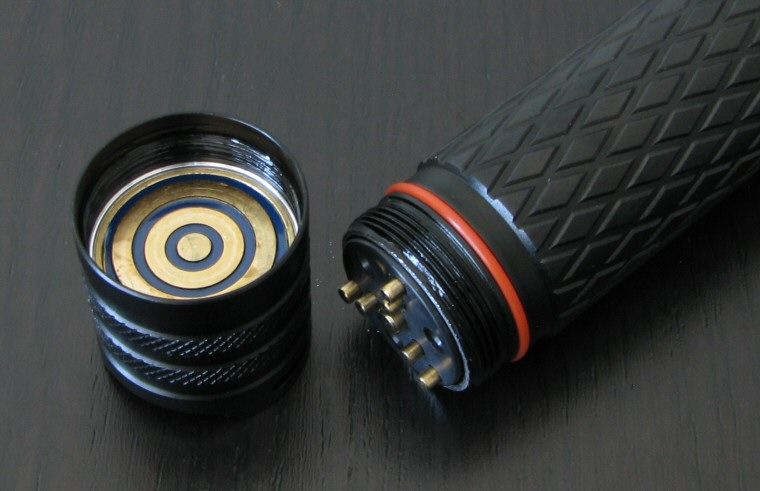
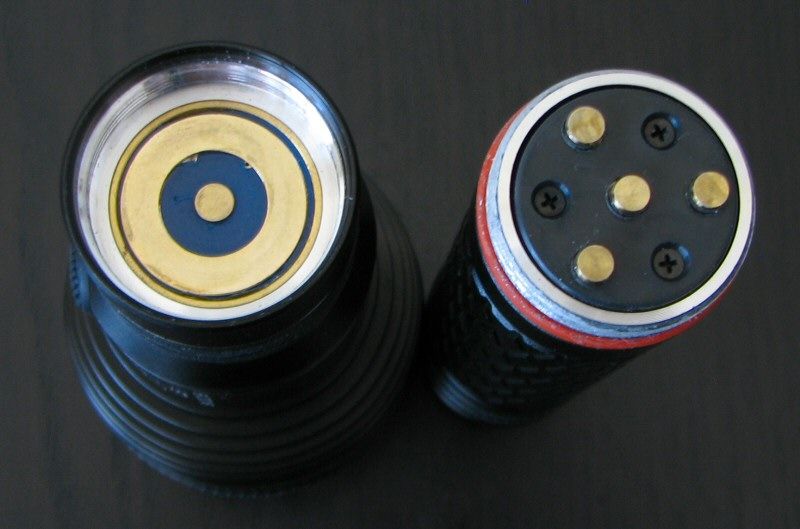
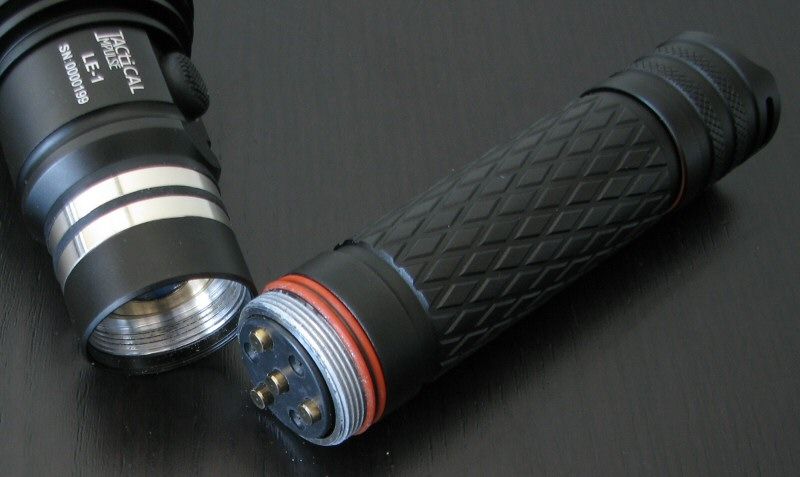
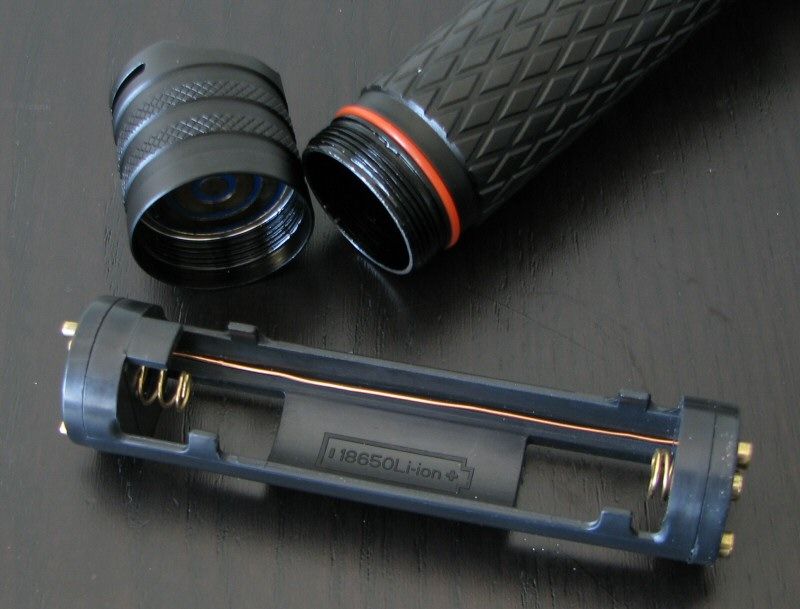
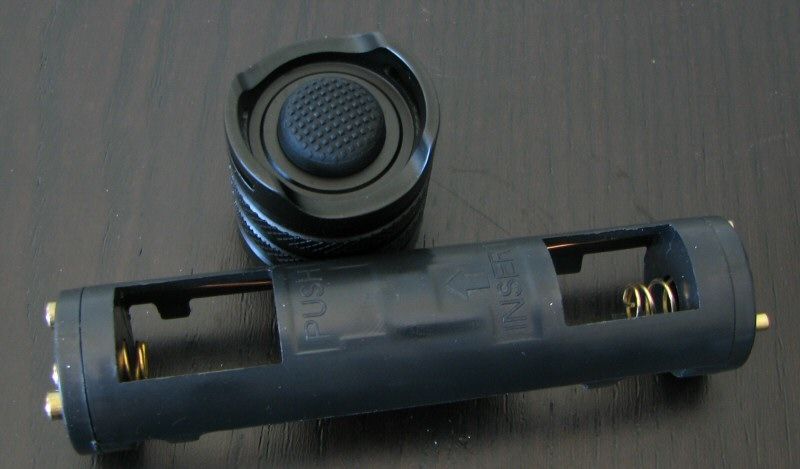
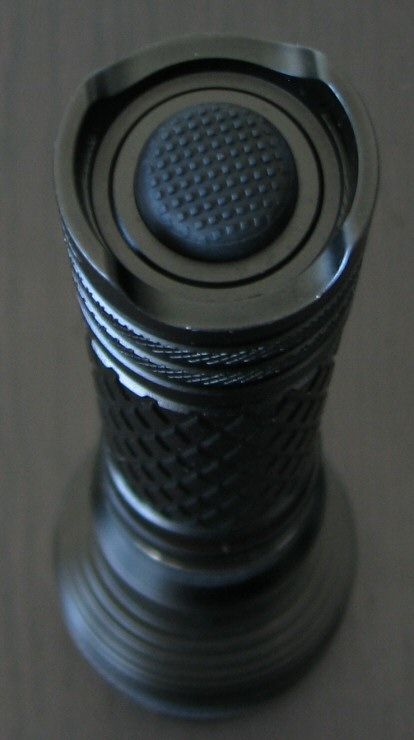
As you can see above, the LE-1 uses a battery carrier for the 18650 cell. This clearly adds to length – I will discuss the carrier specifically a bit later.
Overall, the physical build of the light seems good. Anodizing is of matte finish, and is of good quality (no chips on my sample, and manufacture reports type III). Body labels are very bright and clear, sharp against the black background.
The light doesn't really have knurling per se – instead, there is a checkered pattern across the body handle and in bands on the tailcap, similar to some Thrunite and Niwalker lights. It is not very aggressive on the LE-1, but does help with grip. Note there is no clip, grip ring or lanyard included with the light (although there are lanyard attachment points in the tailcap).
Screw threads are traditional triangular cut, and seem of good quality (anodized at the tailcap for lock-out). :thumbsup: There are double o-rings in the head, single in the tail. Note there was an almost complete absence of lube on my sample, which contributed to noisy threading.
I will discuss the build of the battery carrier below, but there are a series of contact points at both ends that connect to the head/tailcap (i.e., 2 sets of contacts in the head, 3 sets in the tail). The reasons for these will become obvious when I discuss the user interface and optional accessories.
There are two electronic switches on the light, one in the head and one on the tailcap. Both have similar function, and can control the light independently. Both are dual-stage (i.e, partial press to reach the first resistance point, press further to reach the second point with a definite click). Scroll down for a discussion of the interface.
There are two shiny metal bands at the base of the head. These are used with the optional charging cradle dock to charge a 18650 inside the light. They are also used by the duty belt holster, to inactivate the light while holstered. I am happy to report that I was unable to detect an open voltage across the bands (i.e., there is no apparent risk of shorting your cells). Instead, I am able to detect the presence of a magnet in both the holster and charging cradle – the LE-1 thus seems to use a magnetic dock for charging and/or inactivation purposes (i.e., like the Klarus RS-11 and L3 Illumination X40).
Instead, I am able to detect the presence of a magnet in both the holster and charging cradle – the LE-1 thus seems to use a magnetic dock for charging and/or inactivation purposes (i.e., like the Klarus RS-11 and L3 Illumination X40).
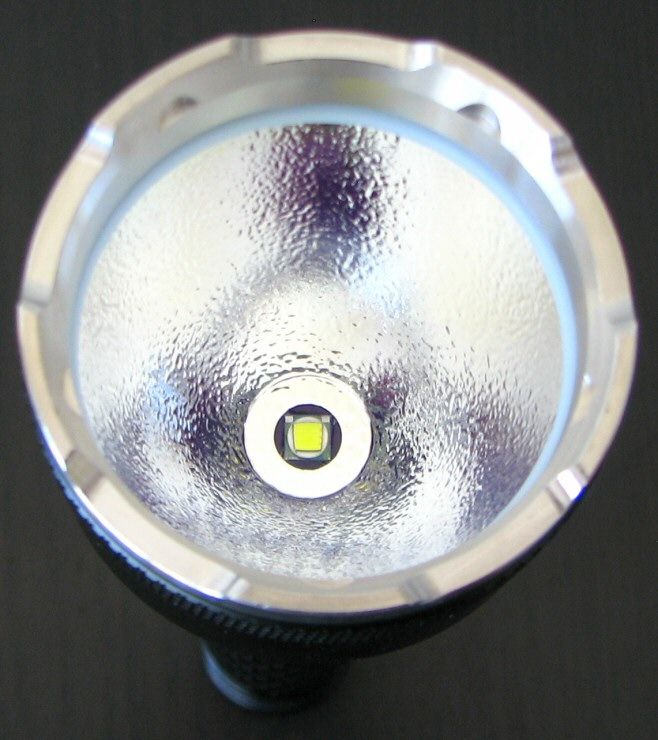
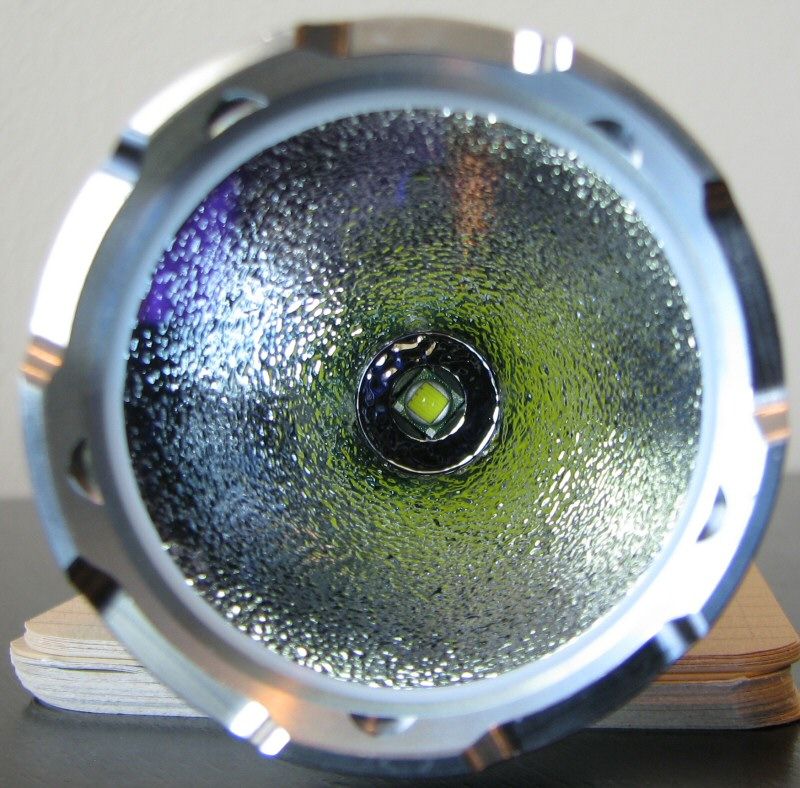
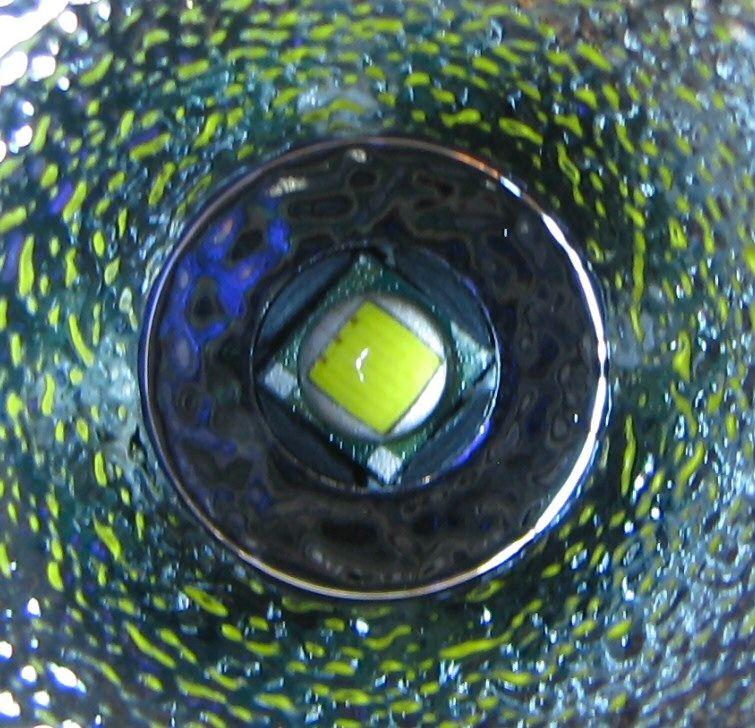
Reflector is heavily textured (i.e., heavy orange peel). XM-L emitter (Cool White tint) was well centered on my sample. There is a crenelated stainless steel bezel and visible anti-glare coating on the lens. See beamshots later in this review.
Battery Carrier

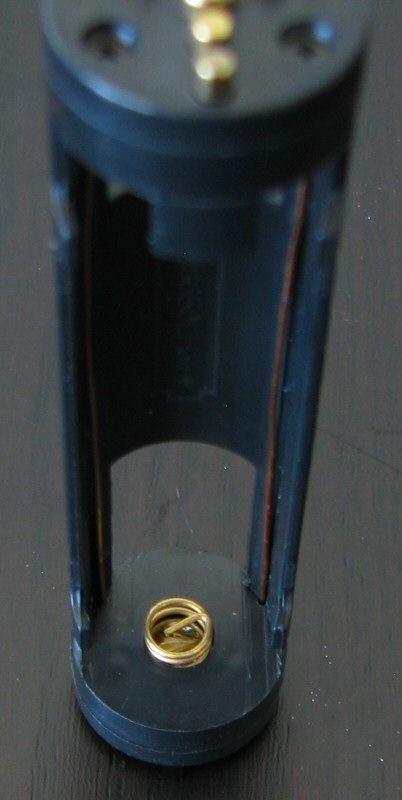
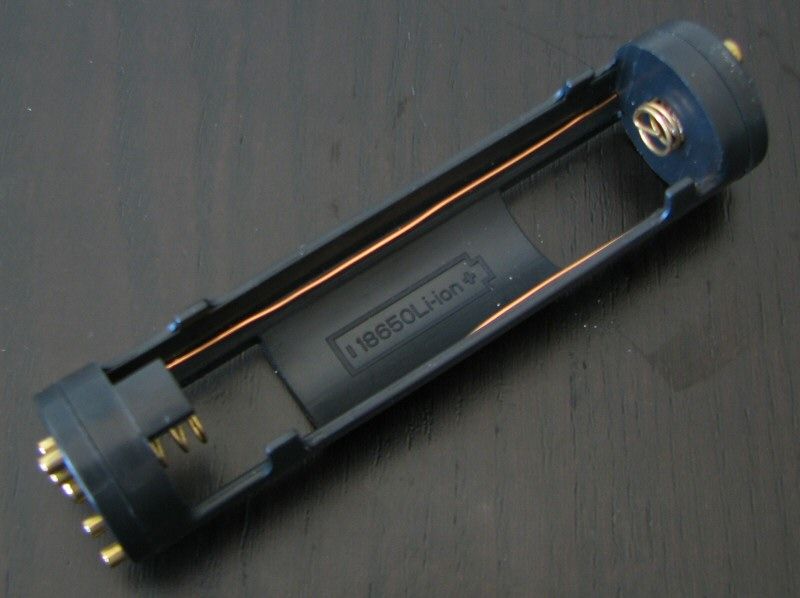
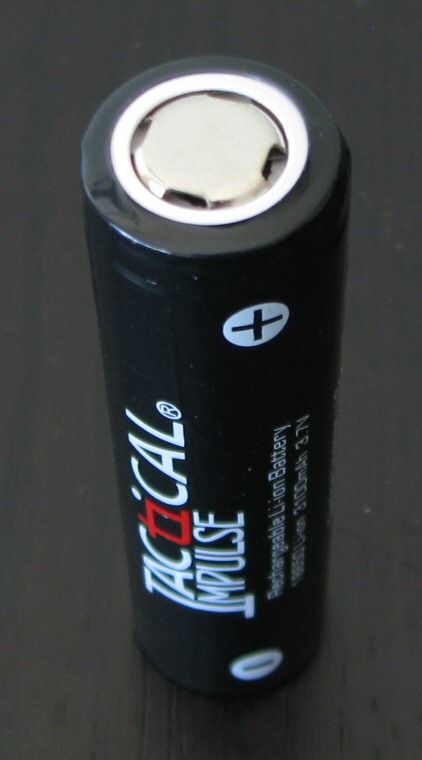
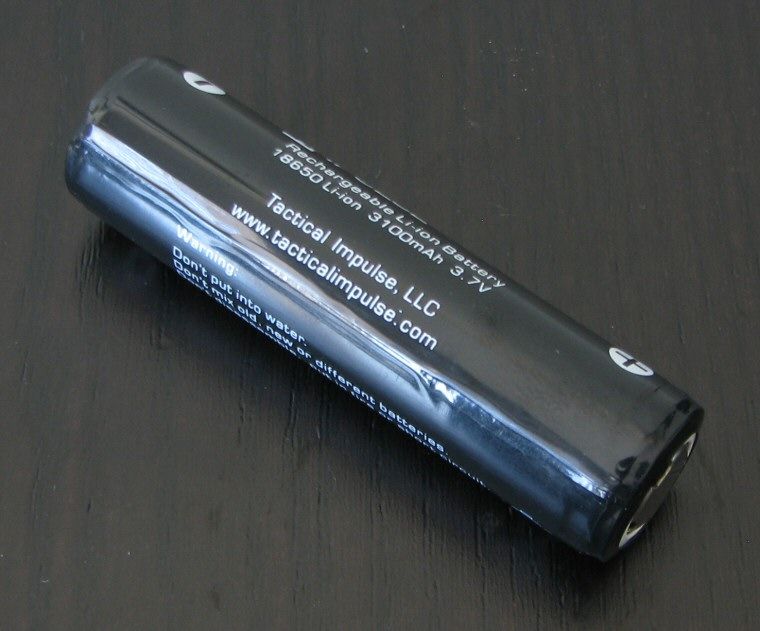
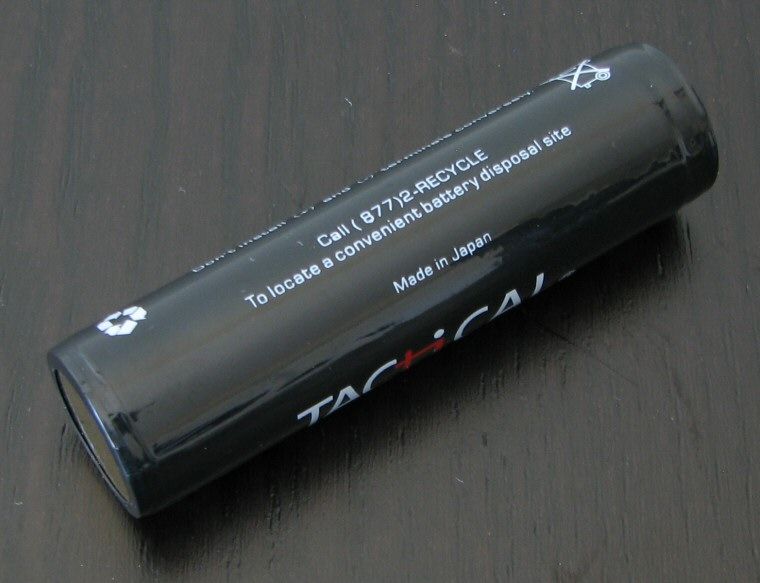
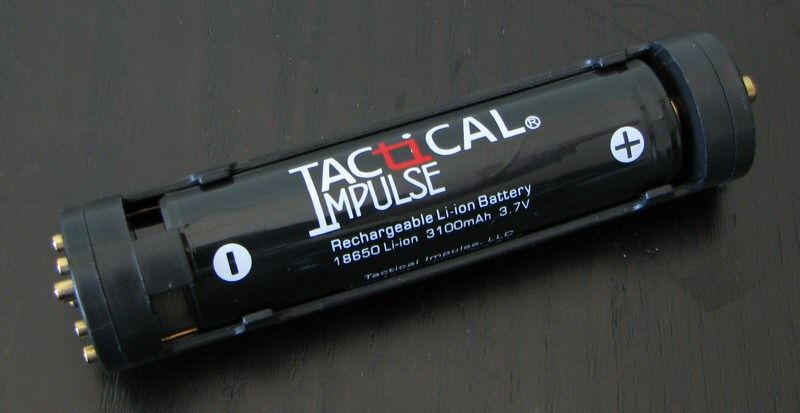
The battery carrier is certainly unique on this light. In addition to external contacts mentioned previously, there are springs at both the negative and positive terminal areas. This means that flat-top cells can be used, and the 3100mAh protected Tactical Impulse batteries fit fine. One comment here – be careful when inserting a button-top battery into the carrier, as you don't want to bend to the top spring.
As previously mentioned, the LE-1 can charge an 18650 cells inside the light. Combined with the dual switch design (and support for additional accessories), this requires a more complicated carrier wiring. As you can see above, there are two exposed wires that run the length of the inside of the carrier. Be careful not to damage these wires, and always make sure your 18650 cells are fully insulated in their plastic wrap (i.e., you wouldn't want a risk of shorting a contact to these internal wires.
There are a number of accessories available for the light. I am going to start below with the special purpose holster
Smart Holster

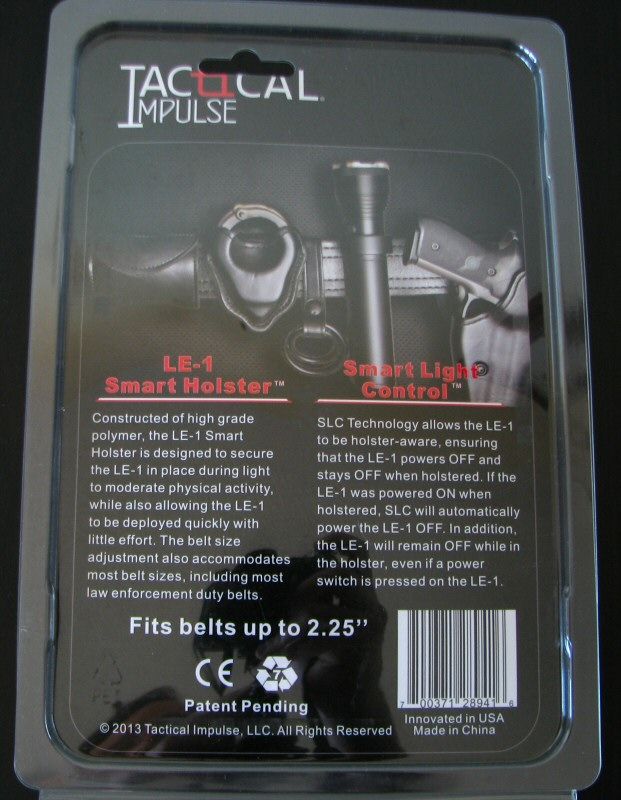
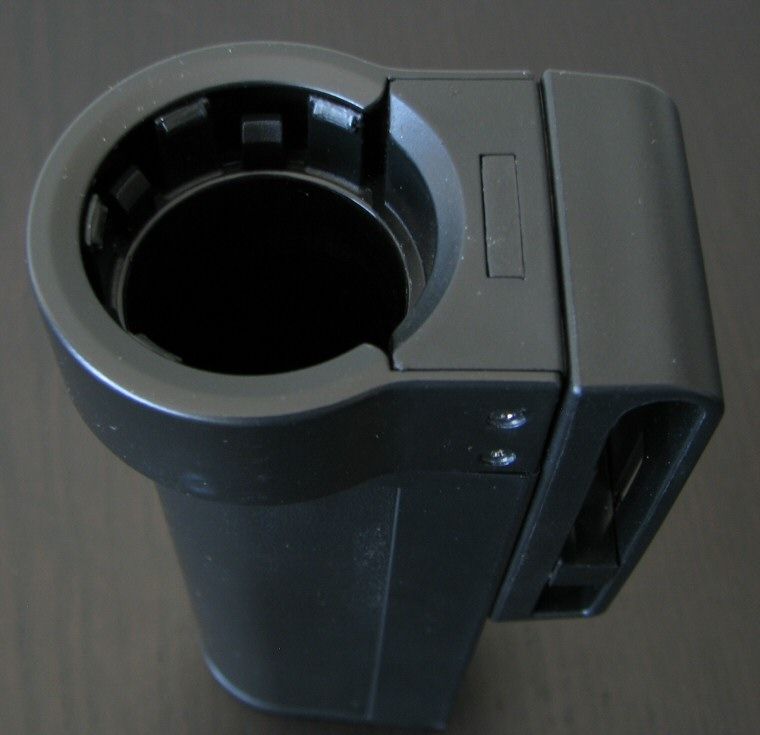
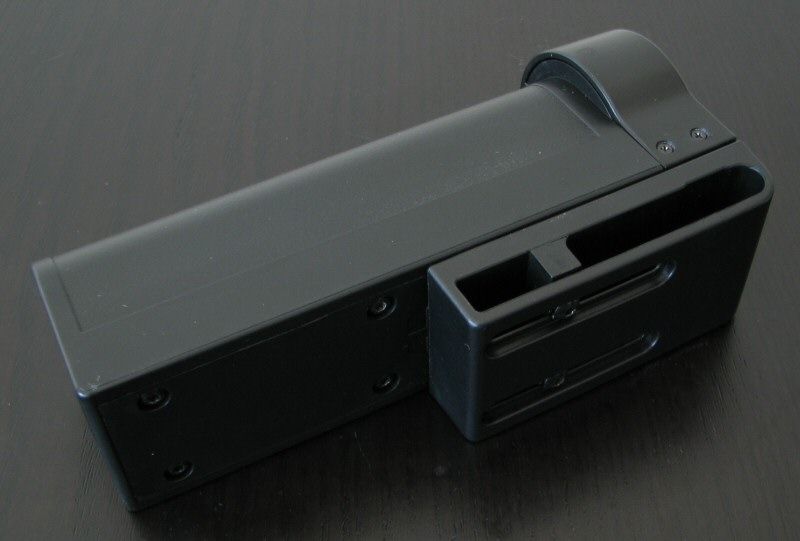
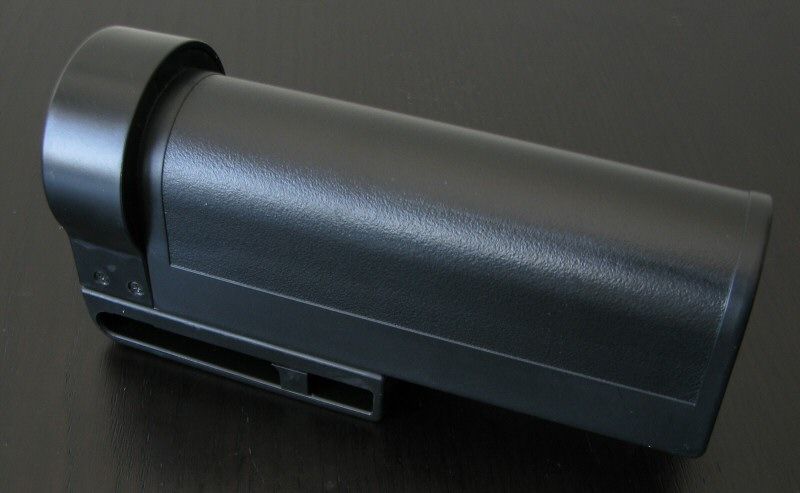
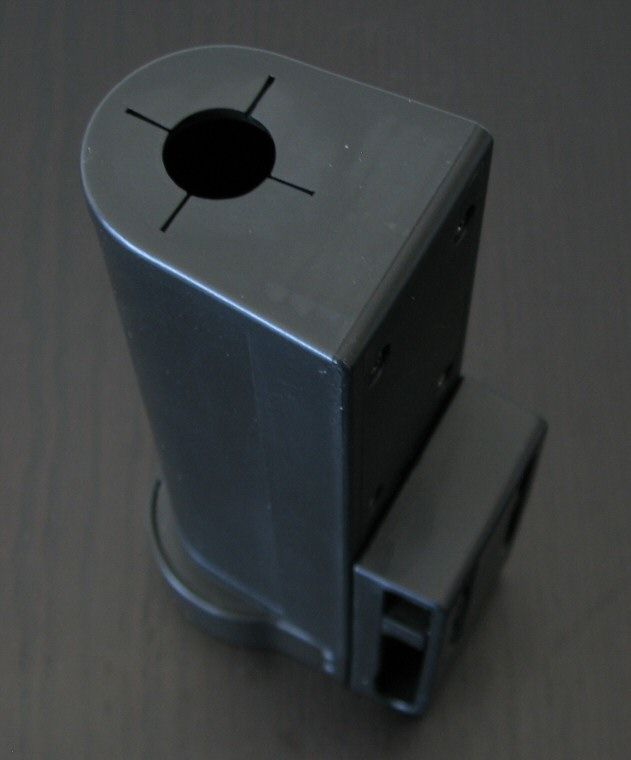
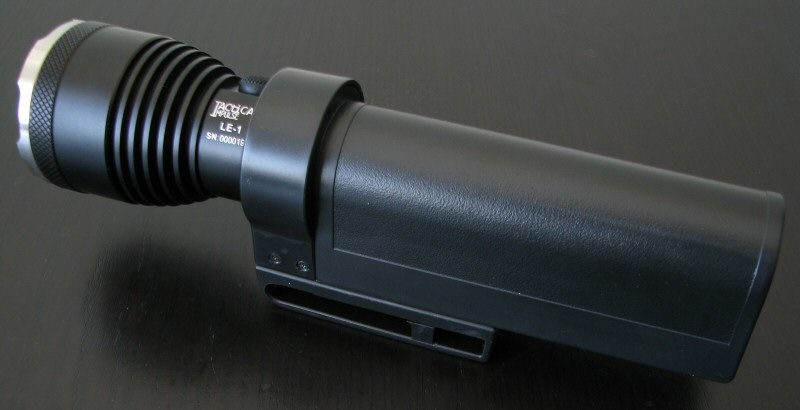
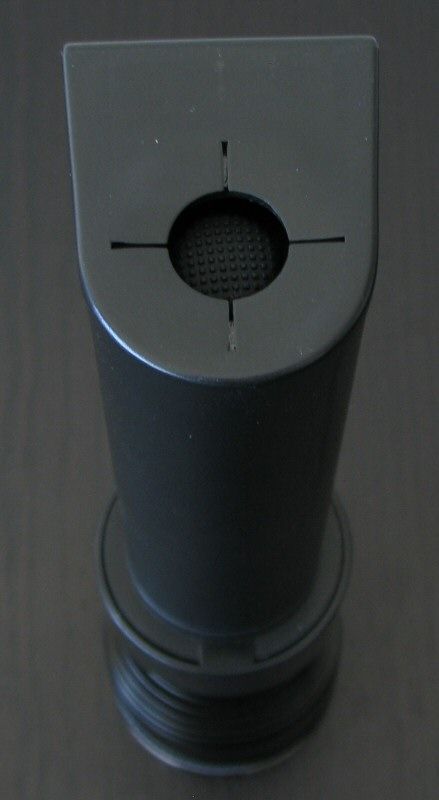
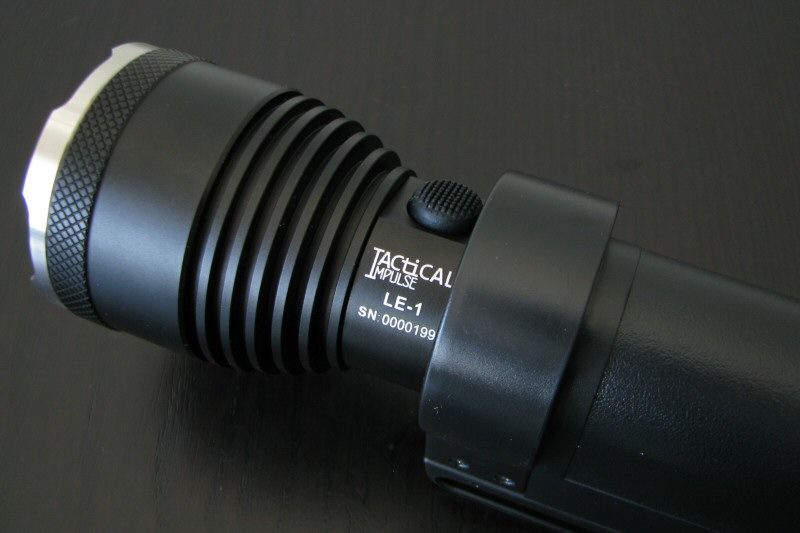
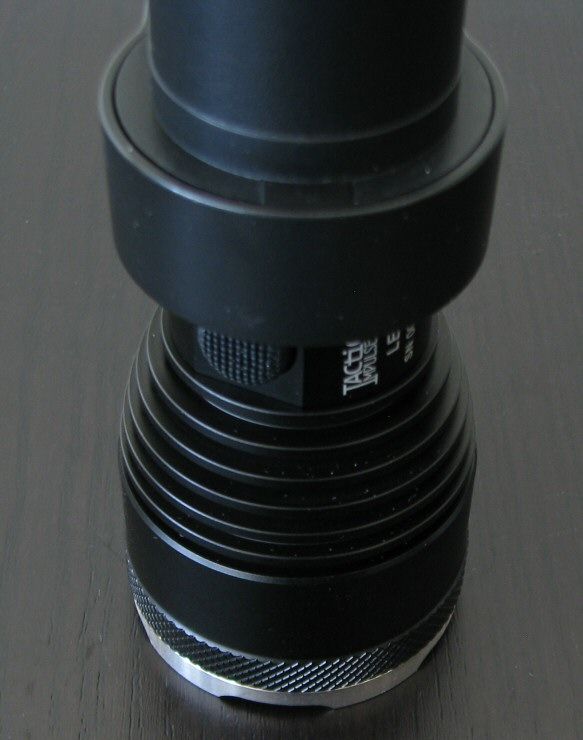
The holster is unlike anything I've seen before. It has a hard shell plastic body, that securely holds the light at the neck region. There is an adjustable belt height control, secured by two screws on either side. This holster is clearly designed for a LEOs duty belt.
There is an opening at the base, allowing you to reach the tail switch – but the light cannot be activated when it is in the holster. In fact, if on, the light shuts offs when securely holstered, and can't be re-activated until it is removed. This is due to the magnetic contact near the head of the holster (i.e., what makes it a "smart" holster).
Note also the holster (or the optional charging cradle described below) does allow you to program the memory feature of the light. By default, mode memory is turned off (i.e., light always activates in max). To turn the memory feature On, you have to press and hold the main power switch for 5 secs when holstered/cradled. The light will flash to let you know memory programming has been set. You must use the holster to set/reset this feature.
Charging Cradle/Dock
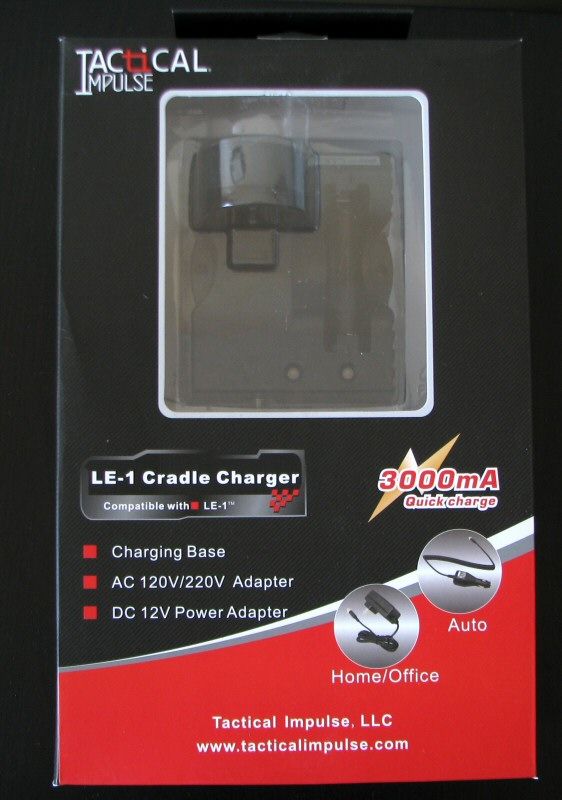
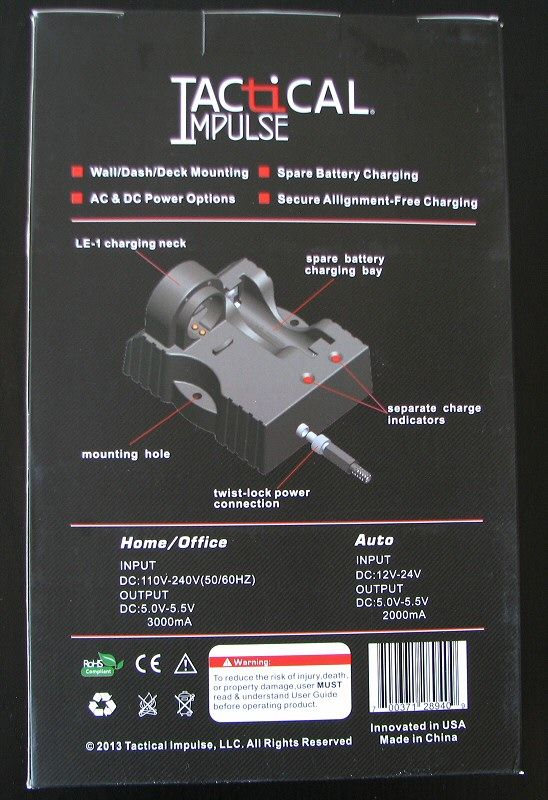
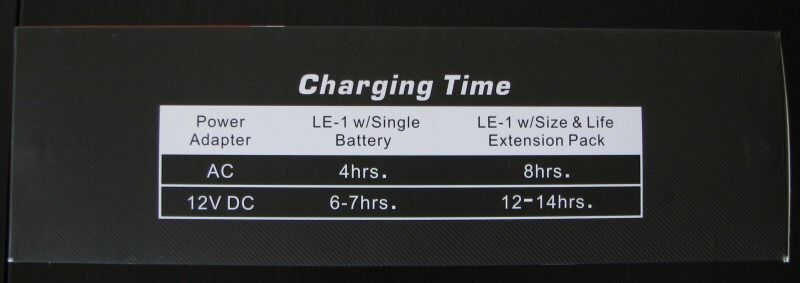
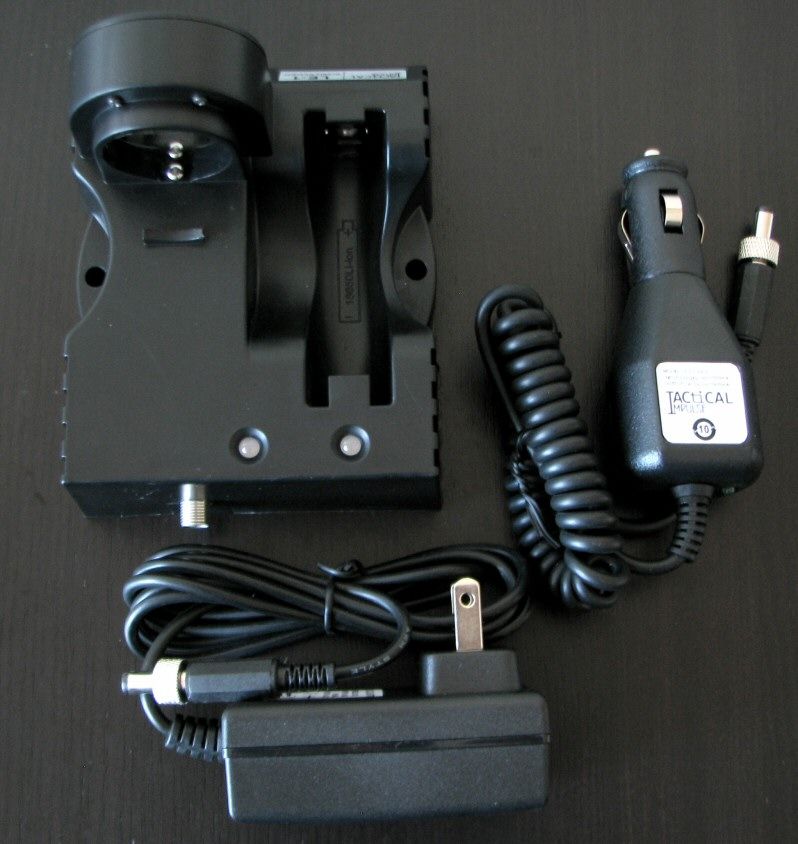
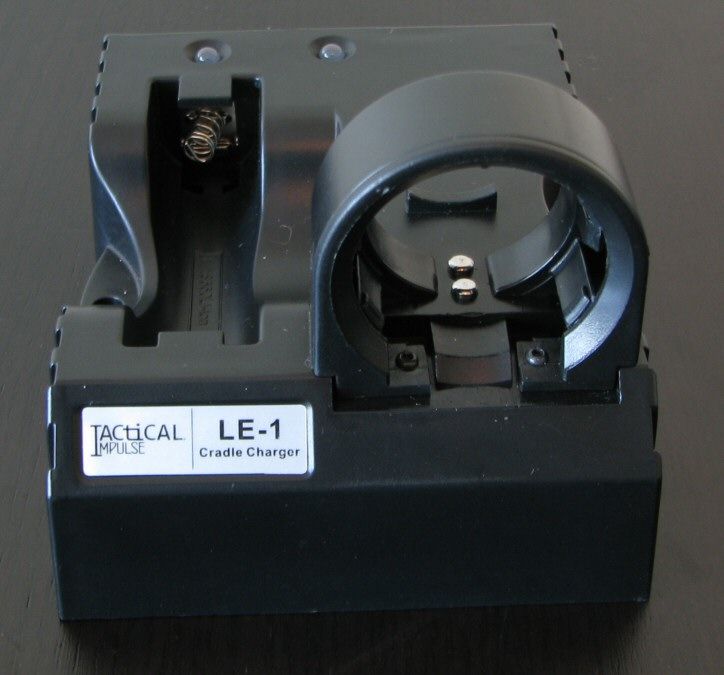
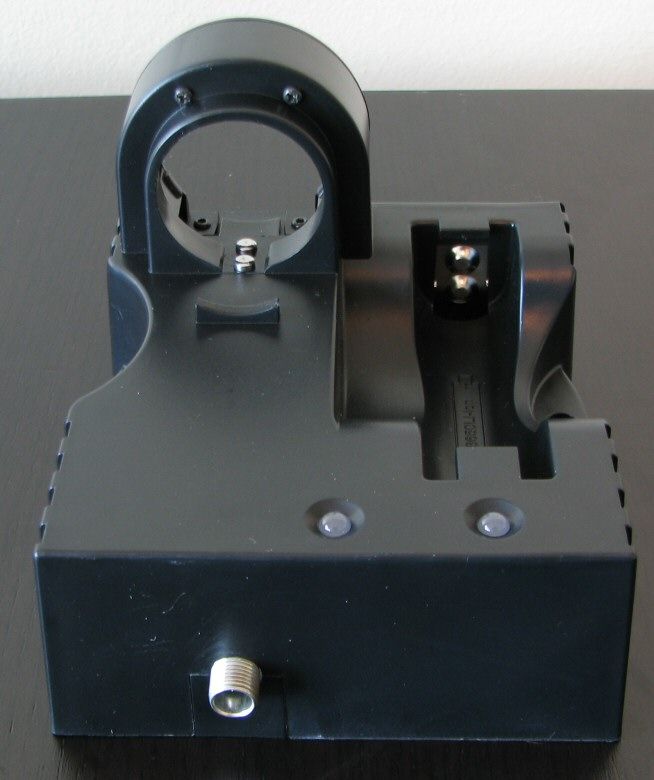
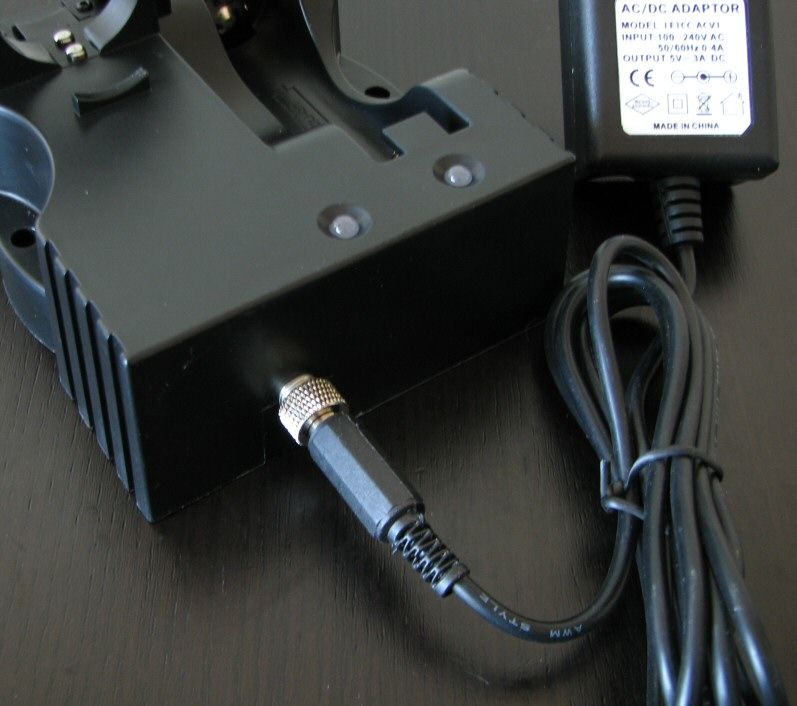
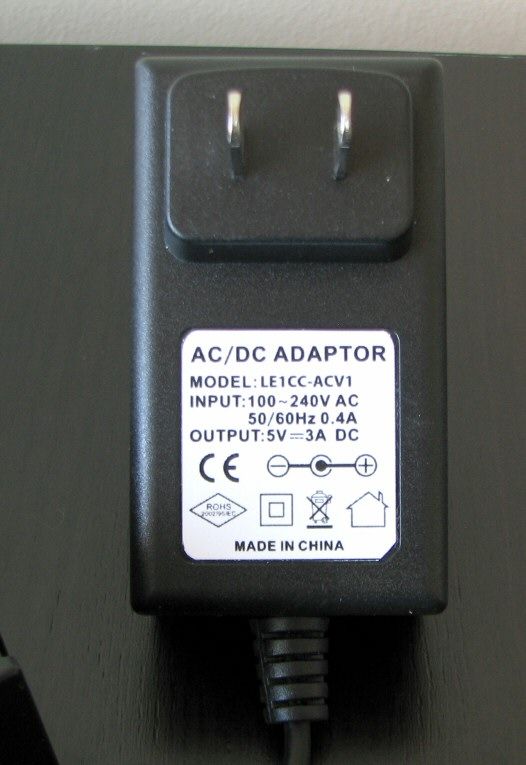
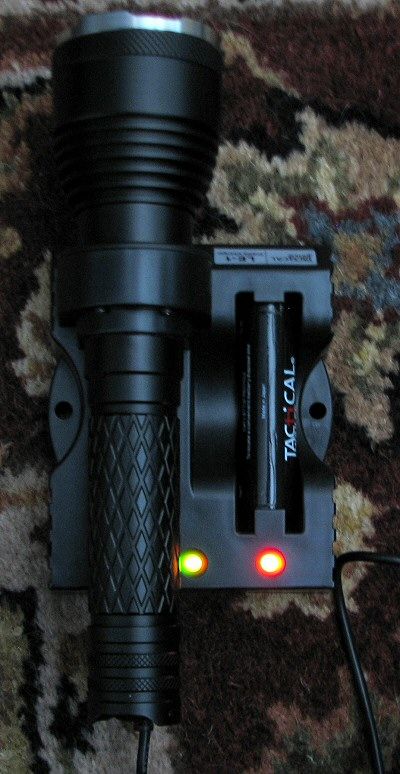
The charging dock is a significant unit, and can be mounted horizontally or vertically. It has a holding ring similar in design to the holster, but with two contacts to allow in-light charging of the 18650 cell. As with the holster, you can use this dock to program memory on/off. There is a second charging bay for a spare cell.
The connector for the AC or AC/DC adapter is robust, with a metal screw cover. It holds securely to the base unit, so you don't need to worry about accidental disconnection. :thumbsup:
The two charging ports are reported to be independent, and I have verified this in my testing. However, they do not perform equivalently, as explained below.
Both charging bays have LEDs that light up full green when the slot is empty and power is supplied to the unit. When you plug in a depleted battery in the LE-1 for the in-light bay, or separately in the secondary battery bay, the charger LEDs turn full red. Over the charge cycle though, the in-light bay LED will gradually turn amber and then green (i.e., the green LED starts to come on as the light charges, and gradually replaces the red LED). The secondary bay doesn't show this pattern – the LED remains constant red until it switches over to solid green.
Charging time is also different between the bays. With a 2200mAh 18650 cell, the in-light charging port LED went green after 2hr 30 mins, with a cell resting voltage of ~4.17V. This is a bit low for a fully charged cell, but that's better for the long-term cell health anyway.
The secondary bay is slower to charge a cell – it took just under 4 hours to fully charge the same 2200mAh 18650. However, the resting voltage of the cell in this bay was ~4.25V. That is higher than I would like to see for a resting voltage, since it means the bay charged the cell to beyond the max specs near the end of its cycle. This will shorten the lifespan of a 18650 cell.
That is higher than I would like to see for a resting voltage, since it means the bay charged the cell to beyond the max specs near the end of its cycle. This will shorten the lifespan of a 18650 cell.
I am unable to measure the current charging characteristics of the in-light charger, but I can confirm that the secondary bay charger doesn't completely terminate when the light goes green – instead, it drops down to a constant 4uA current. This is low enough to not cause a problem (i.e., this is not a "trickle charge", which would be a much higher mA current). Nevertheless, I don't recommend you ever leave a cell plugged into any charger once fully charged.
Battery Extender
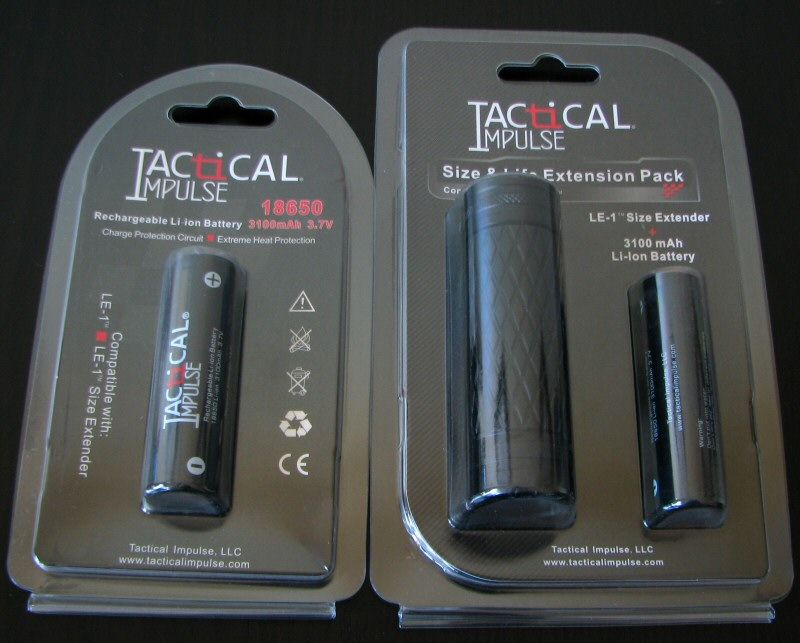
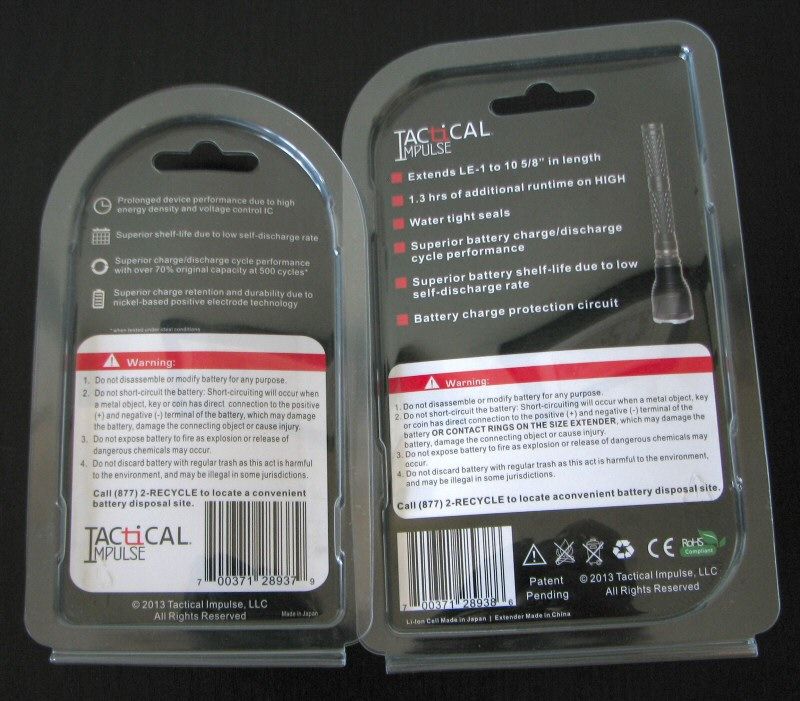
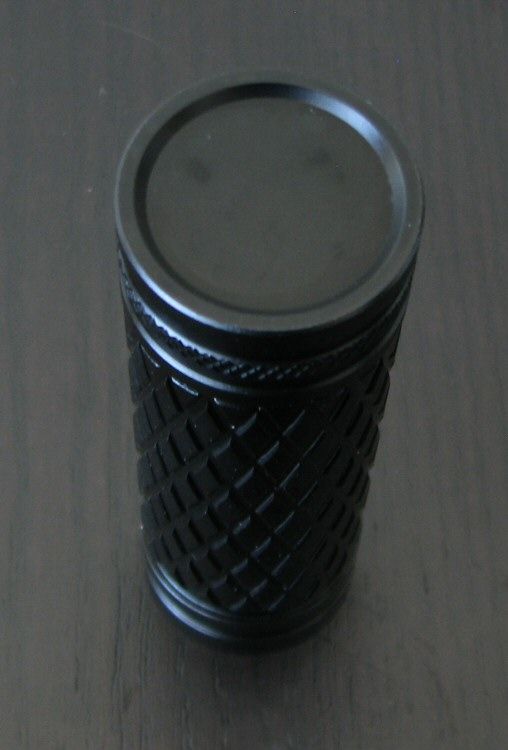
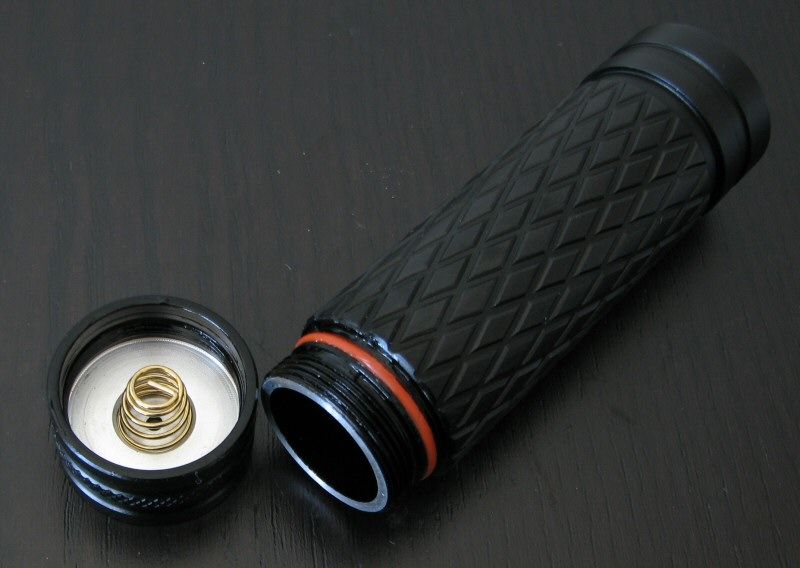
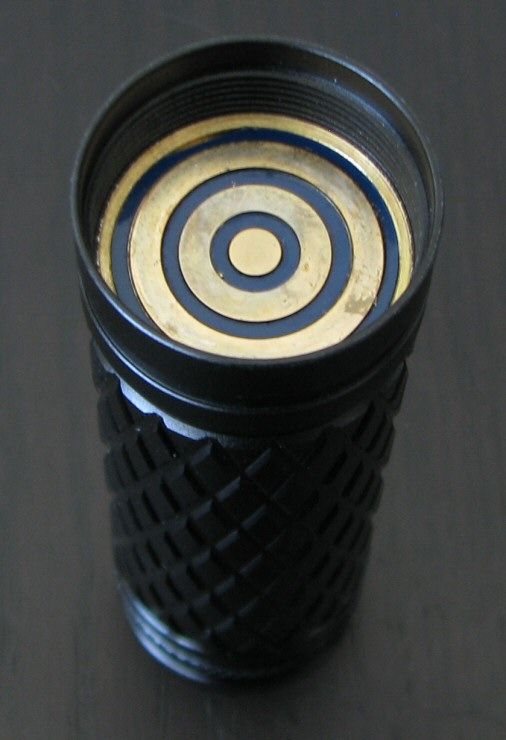
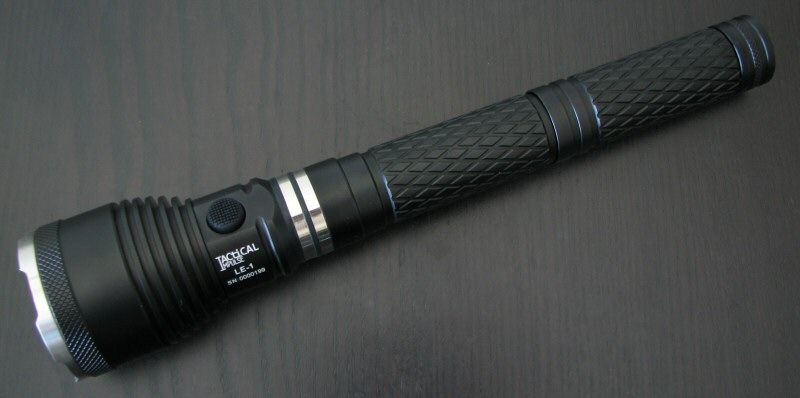
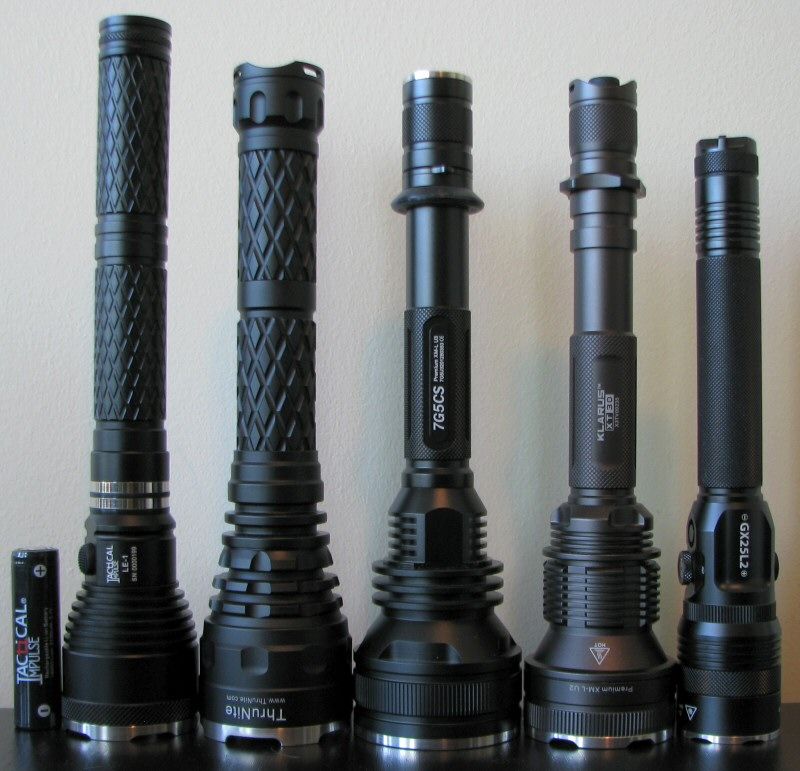
From left to right: Tactical Impulse Protected 3100mAh 18650, LE-1 (with extra 18650 extender); Thrunite Catapult V3; Crelant 7G5CS; Klarus XT-30; Eagletac GX25L2.
All dimensions directly measured, and given with no batteries installed:
Tactical Impulse LE-1: Weight: 334.2g, Length: 270mm, Width (bezel): 52.0mm
ArmyTek Barracuda: Weight 400.8g, Length 264mm, Width (bezel): 64.0mm
Crelant 7G5CS: Weight: 334.5g, Length: 247mm Width (bezel): 64.0mm
Eagletac GX25L2: Weight: 198.3g (with battery pack: 290.1g), Length: 224mm, Width (bezel): 39.5mm
Eagletac GX25L2 Turbo: Weight: 320.7g (with battery pack: 412.5g), Length: 251mm, Width (bezel): 62.0mm
Klarus XT30: Weight: 283.1g, Length: 247mm, Width (bezel): 58.0mm
Niwalker 750N1: Weight: 408.0g, Length: 269mm, Width (bezel): 58.6mm
Olight M3X with Extender: Weight 277.8g, Length 244mm, Width (bezel): 62.3mm
Thrunite Catapult V3: Weight: 434.8g, Length: 254mm, Width (bezel) 58.0mm, Width (tailcap) 35.1mm.
To install the extender unit, remove the tailcap switch of the LE-1. With the battery extender unit in place, you can insert a second 18650 cell to double the runtime of the light. Note the extender doesn't use a carrier – instead, simply place the second cell in the same orientation as the first (i.e., positive terminal toward the head)
The extender unit has a flat base with a spring. No tail switch is now possible, due to the design – you control the light solely by the head switch now.
Note the extender cannot be used with the LE-1 duty holster, due to the closed-in base. This holster design was apparently developed to prevent the light from getting accidentally snagged on a seat belt, or other restraint.
An interesting feature to the design is that the extender battery actually runs parallel to the primary carrier cell (i.e., they are NOT in series). This means that you can run the light with only battery in the extender portion (i.e., nothing in the main carrier). It's an interesting configuration for someone looking to balance the weight, or swap cells by swapping extenders, etc.
Traffic wand
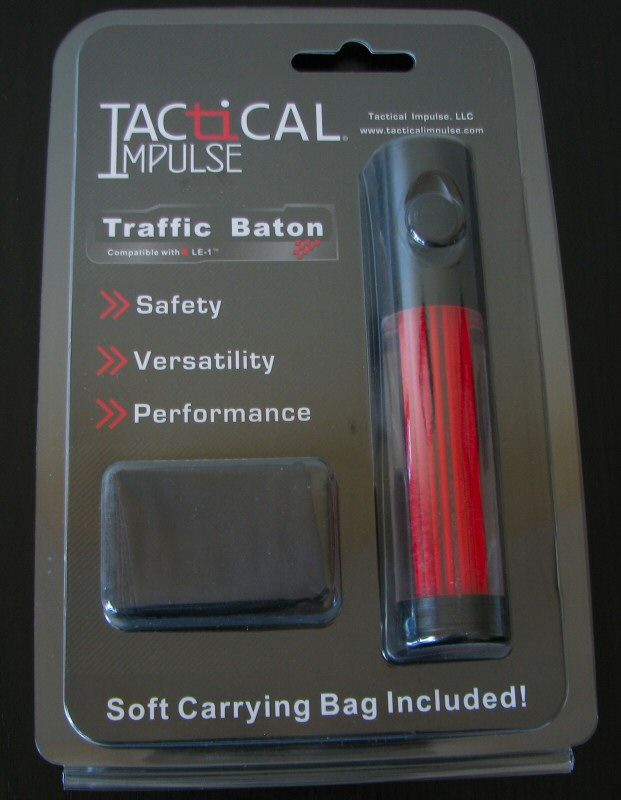
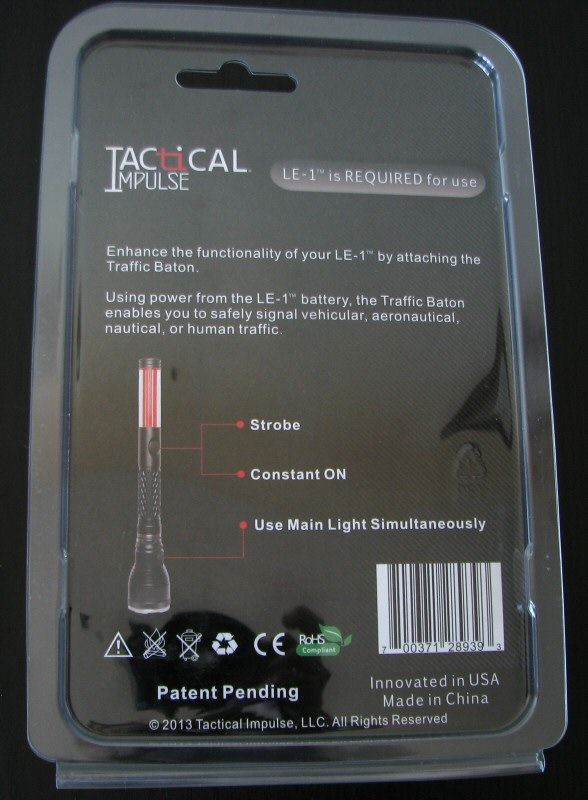
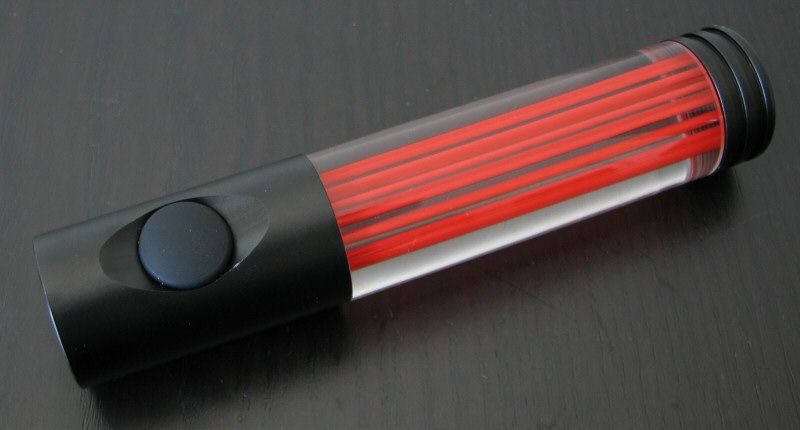
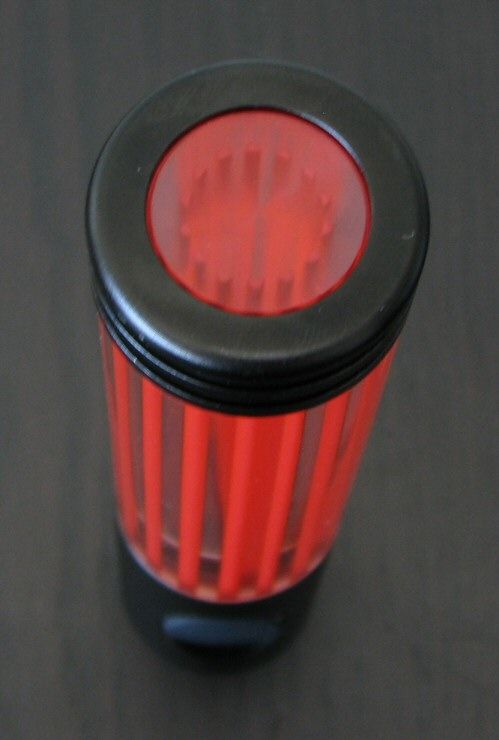
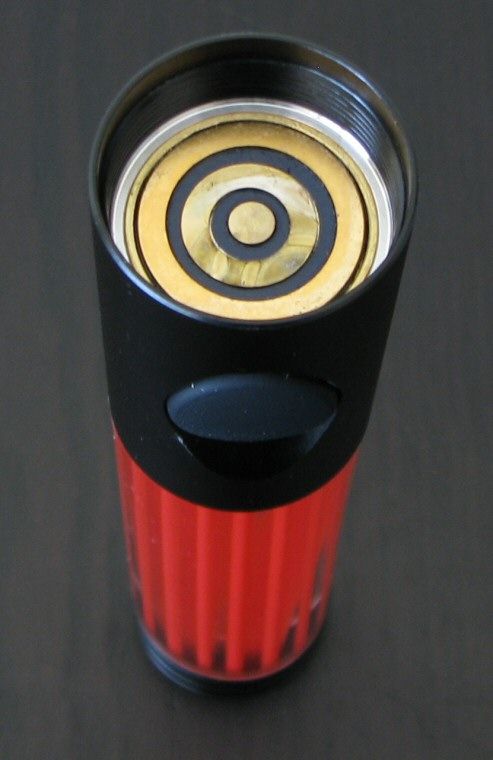
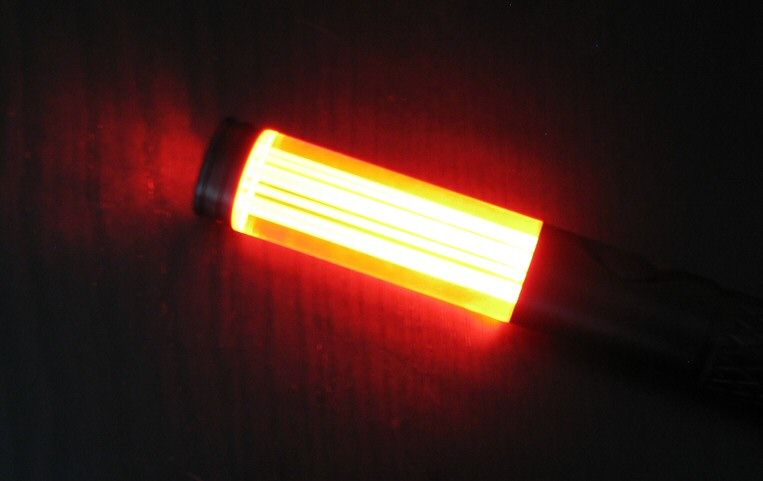
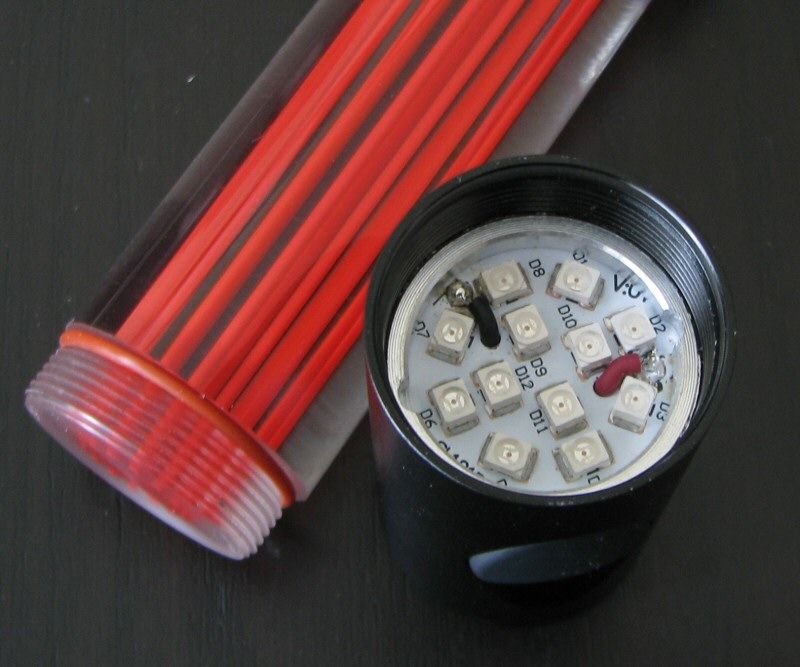
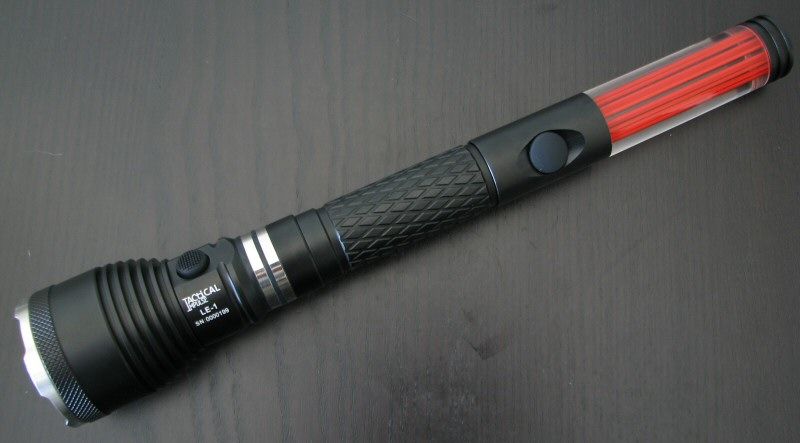
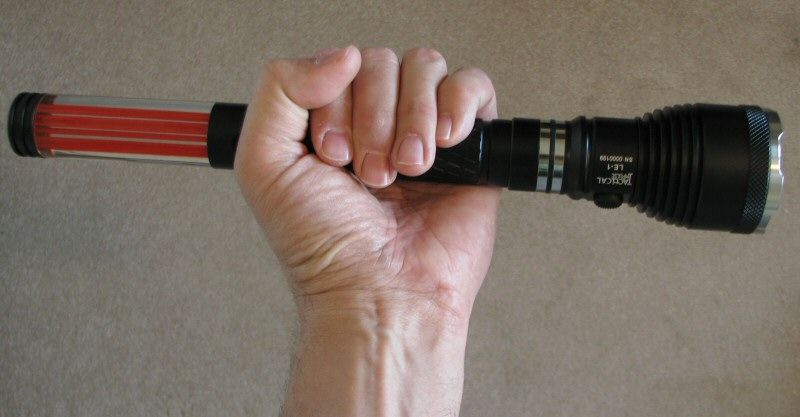
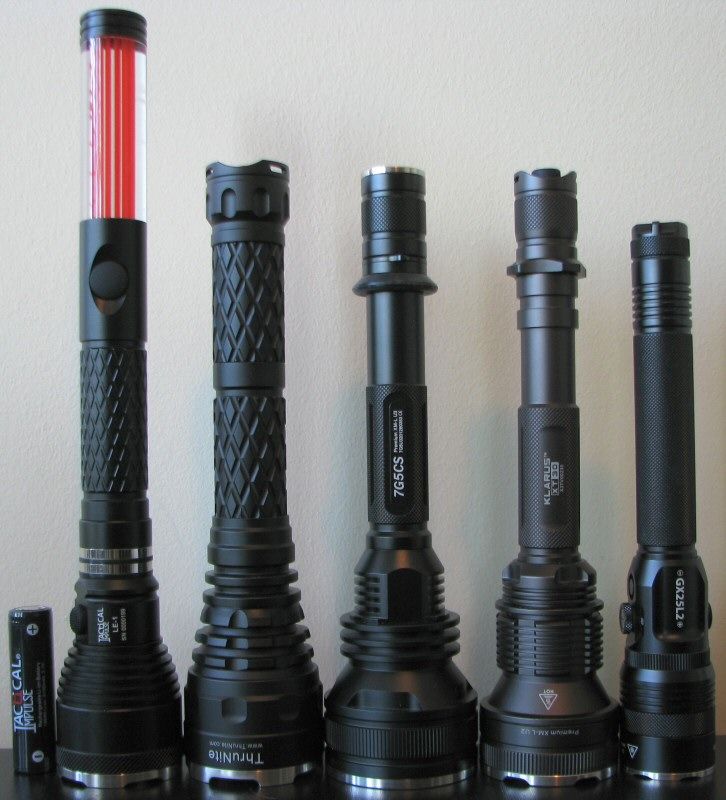
From left to right: Tactical Impulse Protected 3100mAh 18650, LE-1 (with red light kit); Thrunite Catapult V3; Crelant 7G5CS; Klarus XT-30; Eagletac GX25L2.
The traffic wand is also pretty unique in my experience. It screws on to the base of the LE-1, once you remove the tailcap, and draws power from the main cell in the LE-1. It is composed of a series of red rods in an acrylic base, with red LEDs at the base of the switch unit.
There is a control switch on the Traffic wand – click (press release) to turn on in solid red. Click again for a slow signaling red strobe/beacon. Click a third time for off.
Note the main LE-1 switch can still function independently from the traffic wand accessory (i.e., you can have both on at the same time). Now you can probably see why there is a battery carrier and so many connection points.
The LE-1 won't fit into the holster with the traffic wand assembly attached.
User Interface
Basic user interface for the LE-1 is controlled by either electronic switch (i.e., the tail switch and head switch function exactly the same way).
Both switches are two-stage - press-and-hold to the first resistance point for momentary on (i.e., release to turn off), or press further (i.e., click) for constant locked on.
There are three constant output levels and a strobe controlled by soft-pressing either switch (i.e., a partial press and release). From on, mode sequence is Hi (100%) > Med (50%) > Lo (20%) > Strobe, in a repeating loop.
In default form, there is no mode memory (i.e., always comes on in Hi). This can reprogrammed with memory turned on using the accessory holster or charging dock. To turn the memory feature on, press and hold the main power switch for 5 secs when holstered/cradled. The light will flash to let you know memory programming has been set. You must use the holster to set/reset this feature.
Screw threads are anodized, so you can lock out the light by a twist of the tailcap. Note that light will shut-off automatically if holstered or cradled, in the supplied accessories.
Video:
For information on the LE-1 and all its accessories, please see my rather lengthy video overview:
Video was recorded in 720p, but YouTube typically defaults to 360p. Once the video is running, you can click on the configuration settings icon and select the higher 480p to 720p options. You can also run full-screen.
As with all my videos, I recommend you have annotations turned on. I commonly update the commentary with additional information or clarifications before publicly releasing the video.
PWM/Strobe
As with other lights that offer dual electronic switches, the LE-1 uses Pulse Width Modulation (PWM) for its Lo/Med modes. Unfortunately the LE-1 uses a visually detectable frequency.
PWM Lo
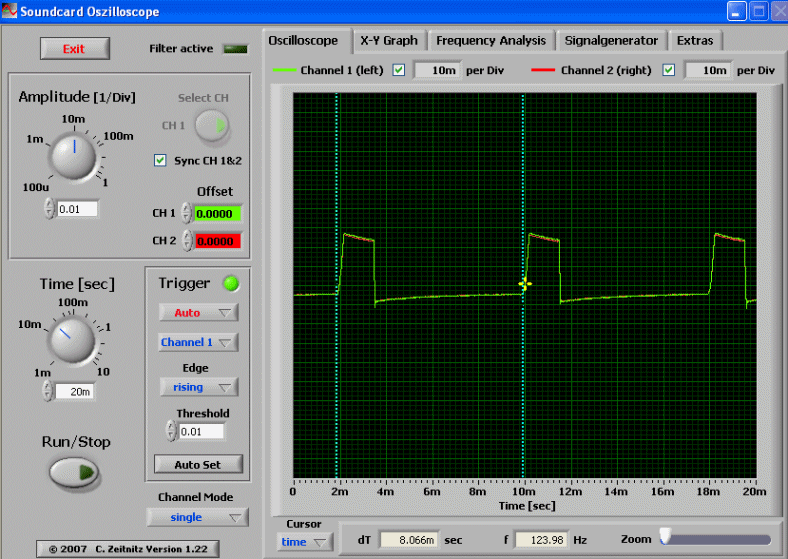
PWM Med
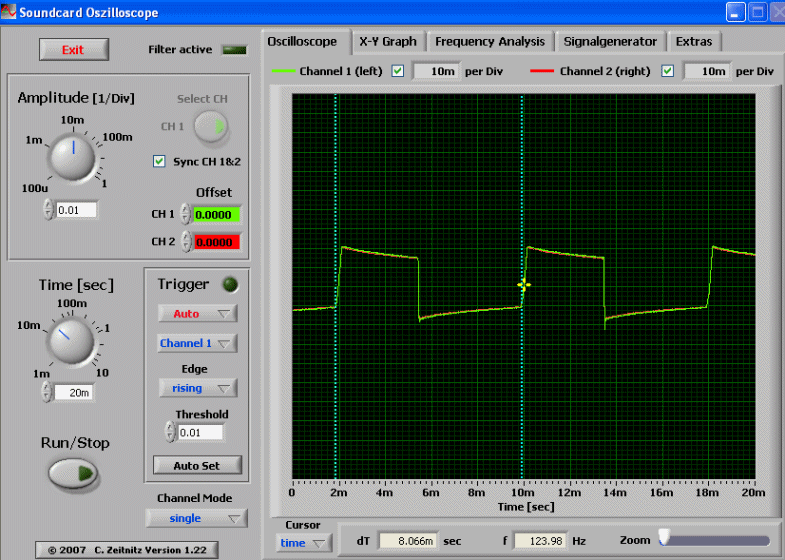
Honestly, it's been awhile since I've seen such a low frequency – 125 Hz is VERY easy to detect visually. :shakehead
I've not sure why they had to opt for such a low PMM frequency. But that being said, I didn't find the LE-1 as distracting as I expected it to be, given this frequency. I suspect the reason for this is the relatively high Lo/Med output modes – 20% and 50% max output are both quite bright. I have found that low freq PWM is most annoying at much lower duty cycles, for some reason.
To give you a comparable, the original Olight M30 (with dual switches) had ~100 Hz PWM. I found it unacceptable at its Lo mode, which was ~2% max output. However, it's Med mode (which was ~20%, the same as the Lo mode here on the LE-1) was much more tolerable. But it is still quite visible, so I encourage Tactical Impulse to raise the 125 Hz frequency significantly.
Strobe:
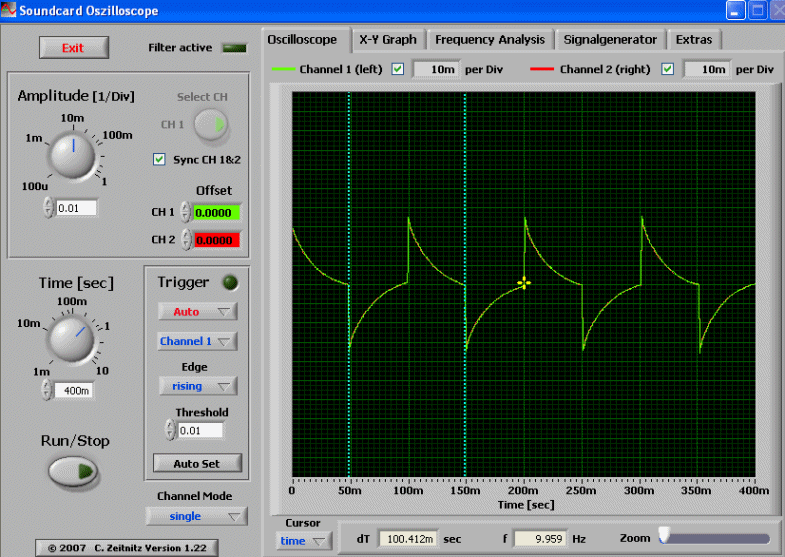
Strobe was a fast "tactical" strobe, of 10 Hz frequency.
Standby Current
Because of the dual electronic switches, the LE-1 will always be drawing a small amount of power when fully connected. It is hard to get a clear reading on this light, due to the the complex wiring arrangement. I have tried to get readings with the extender in place, to simplify the connection, but I get inconsistent results using my DMM. For example, on 2x18650, I measure ~170uA on my DMM's uA scale, but ~8.5mA on my mA scale (both using the uAmA port). With a single 18650 with extender in place, I get ~850uA or ~3.3mA. :thinking: Neither of these sets of results are consistent with each other, given the parallel cell arrangement. As a result, I am not clear as to what the typical standby drain is.
If you are concerned, you can lock out the light by twisting the tailcap a quarter turn. This physically locks out the light, to prevent accidental activation (and seems to remove any drain).
Beamshots:
For white-wall beamshots below, all lights are on Max output on an AW protected 18650 battery. Lights are about ~0.75 meter from a white wall (with the camera ~1.25 meters back from the wall). Automatic white balance on the camera, to minimize tint differences (but there may still be some variation).
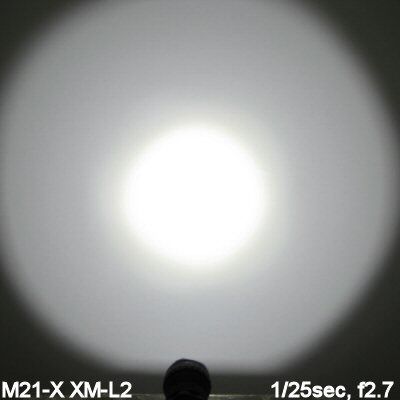

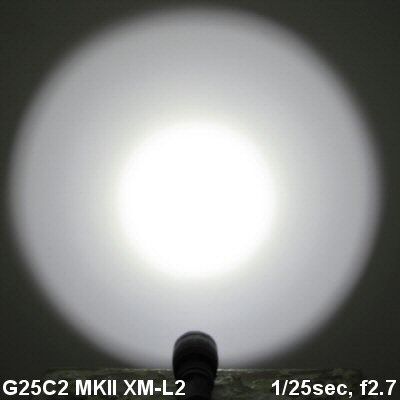
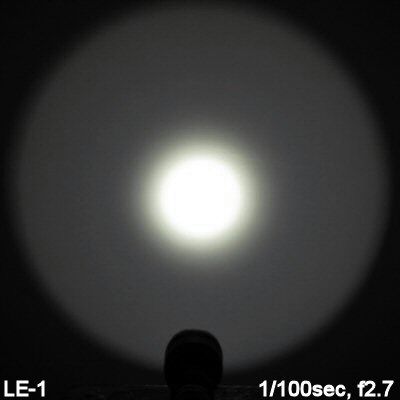
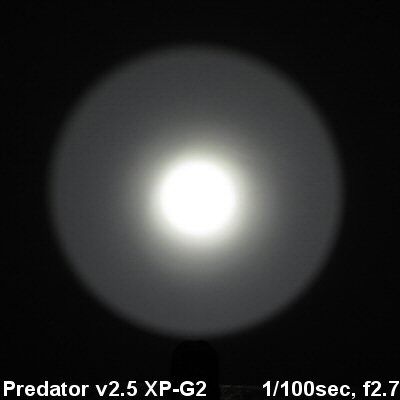
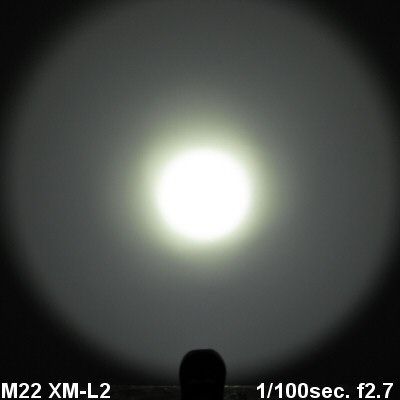
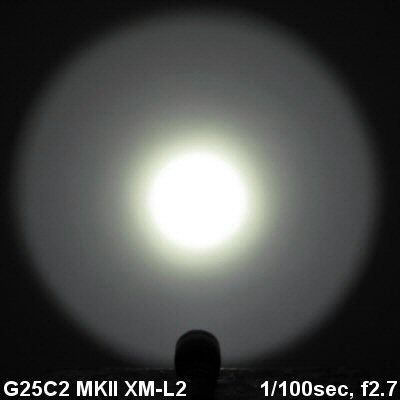
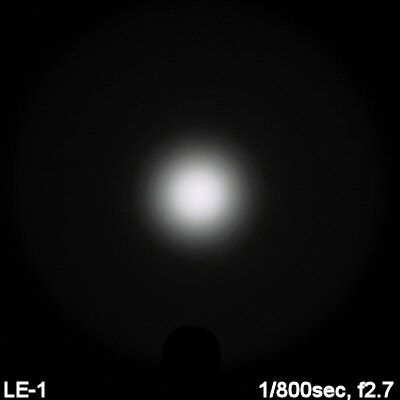
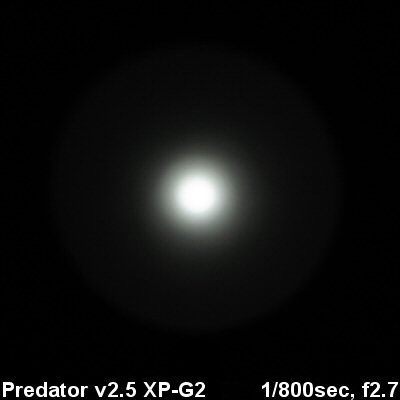
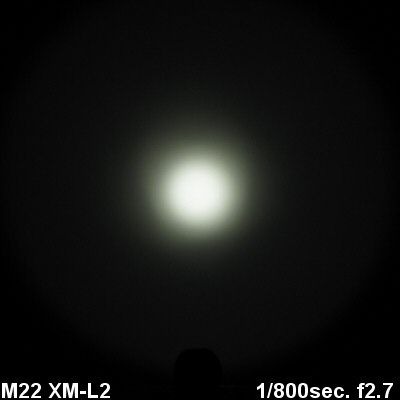
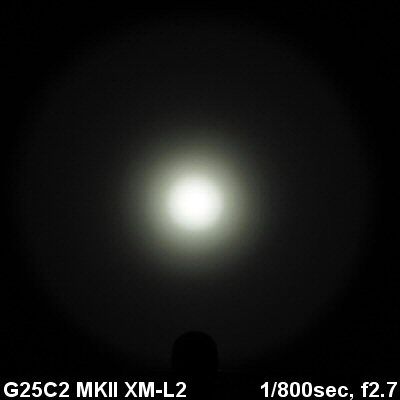
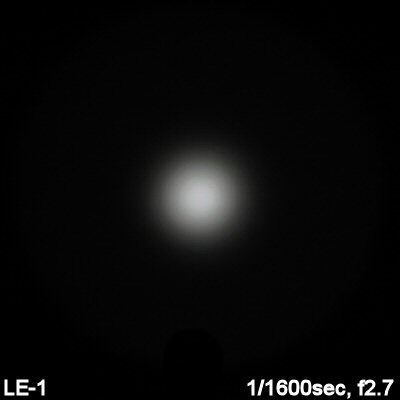
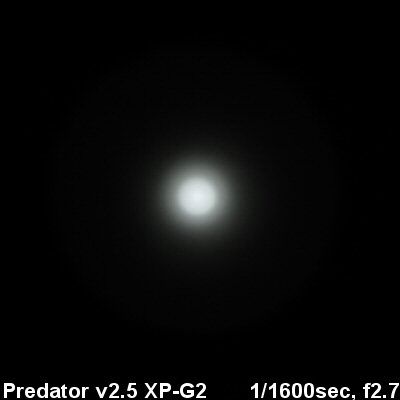
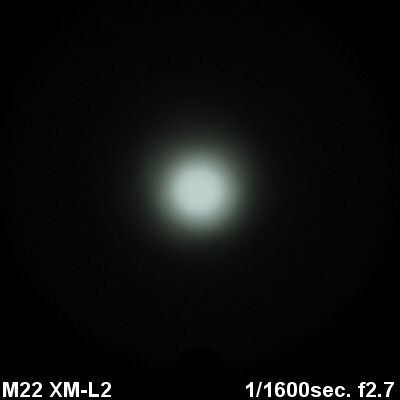
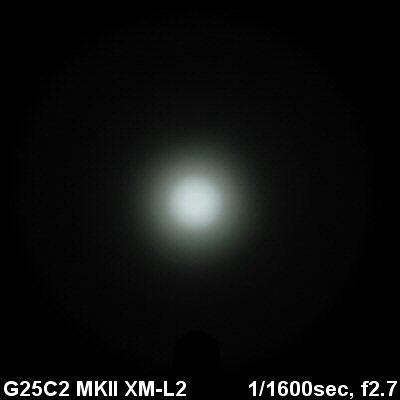
The heavily textured reflector smooths out the hotspot quite bit, and overall spillbeam width is reasonable for the class. Note that I found the tint to be a bit on the purplish-end of cool white on my LE-1 sample (of course, YMMV).
Testing Method:
All my output numbers are relative for my home-made light box setup, a la Quickbeam's flashlightreviews.com method. You can directly compare all my relative output values from different reviews - i.e. an output value of "10" in one graph is the same as "10" in another. All runtimes are done under a cooling fan, except for any extended run Lo/Min modes (i.e. >12 hours) which are done without cooling.
I have devised a method for converting my lightbox relative output values (ROV) to estimated Lumens. See my How to convert Selfbuilt's Lightbox values to Lumens thread for more info.
Throw/Output Summary Chart:
My summary tables are reported in a manner consistent with the ANSI FL-1 standard for flashlight testing. Please see http://www.flashlightreviews.ca/FL1.htm for a discussion, and a description of all the terms used in these tables. Effective July 2012, I have updated all my Peak Intensity/Beam Distance measures with a NIST-certified Extech EA31 lightmeter (orange highlights).
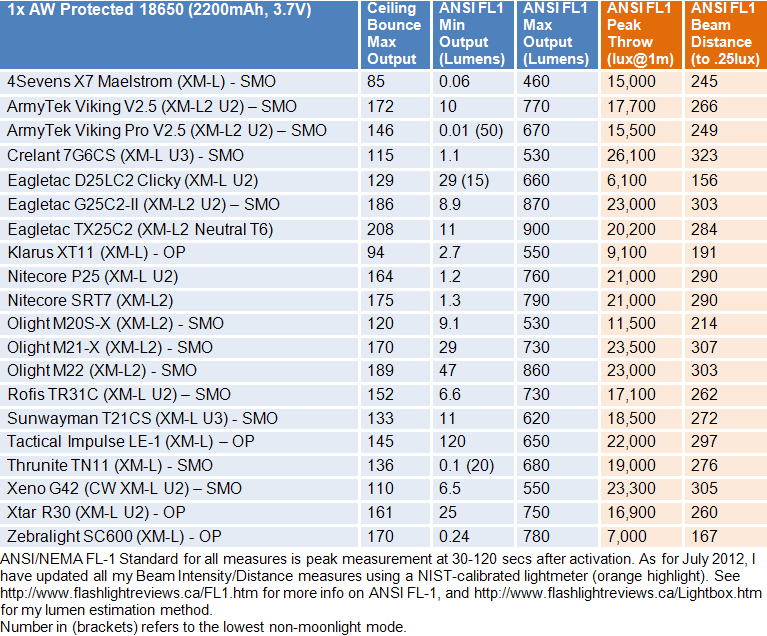
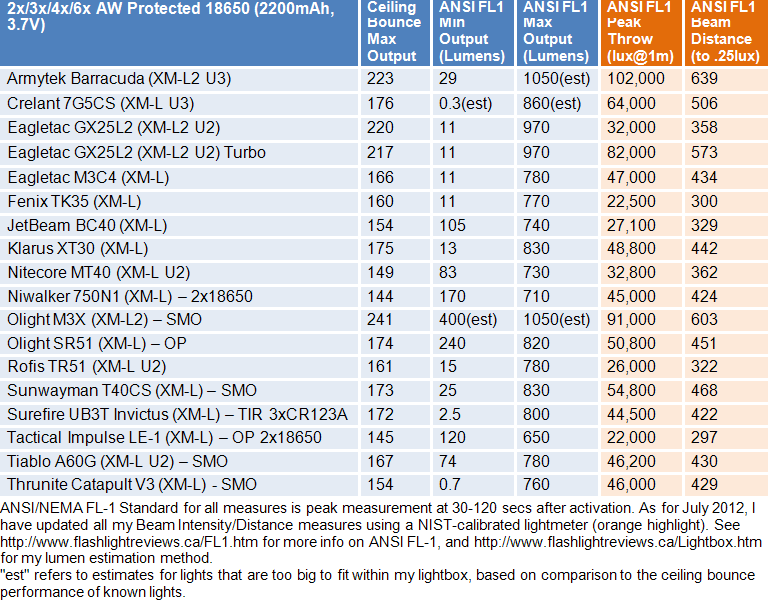
Max output is a bit lower than most recent lights in the 1x18650 class, but consistent with Tactical Impulse's reported specs. There was absolutely no difference in output between 1x18650 and 2x18650.
Note that my directly measured beam intensity was higher than their report ANSI FL-1 spec.
Let's see how output compares across the various levels:
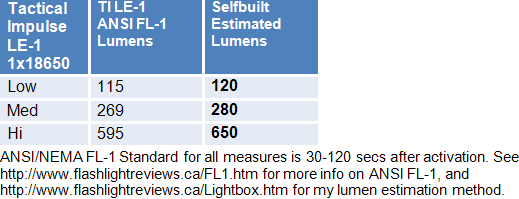
As you can see, my results are fairly consistent across the board with their ANSI FL-1 lumens specs.
Output/Runtime Graphs:
Let's start with a comparison of the Tactical Impulse 3100mAh 18650 cells, compared to my standard AW 2200mAh protected cells.

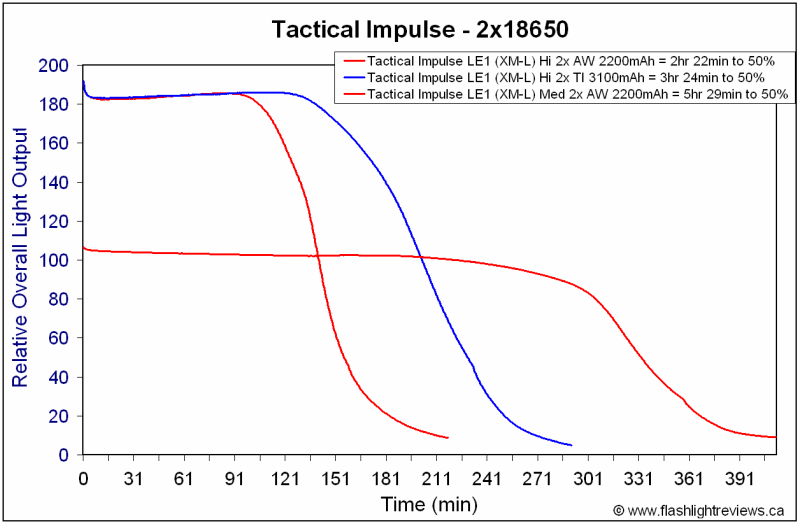
As expected, the 3100mAh cells have proportionately longer runtimes than 2200mAh cells. The LE-1 is partially regulated - after an initial dip, the light maintains flat regulation for a good portion of the run, eventually falling out of regulation as the batteries drain.
Runtimes seems very consistent with reported ANSI FL-1 specs, on the supplied 3100mAh cells. Note I report runtimes as time to 50%, but ANSI FL-1 standard is time to 10%.
How does the LE-1 stack up to the competition? Let's start with the 1x18650 configuration:
Note: Unless otherwise stated, all my 18650 runtimes below are based on AW 2200mAh Protected 18650 cells.
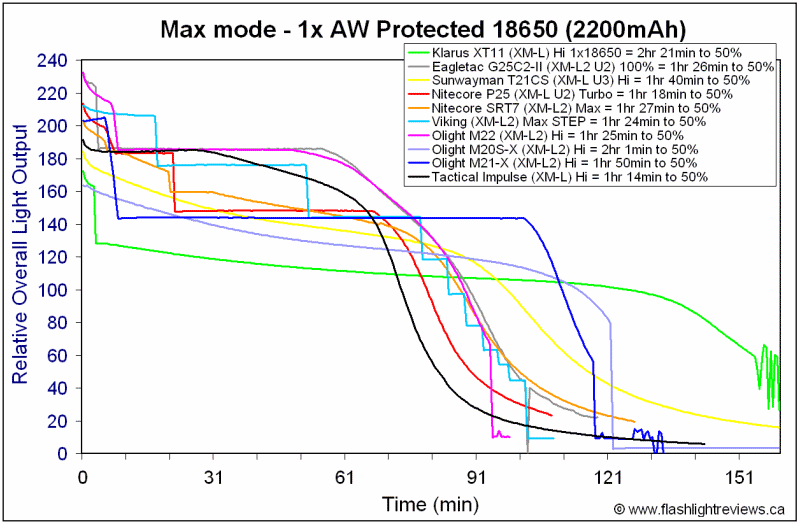
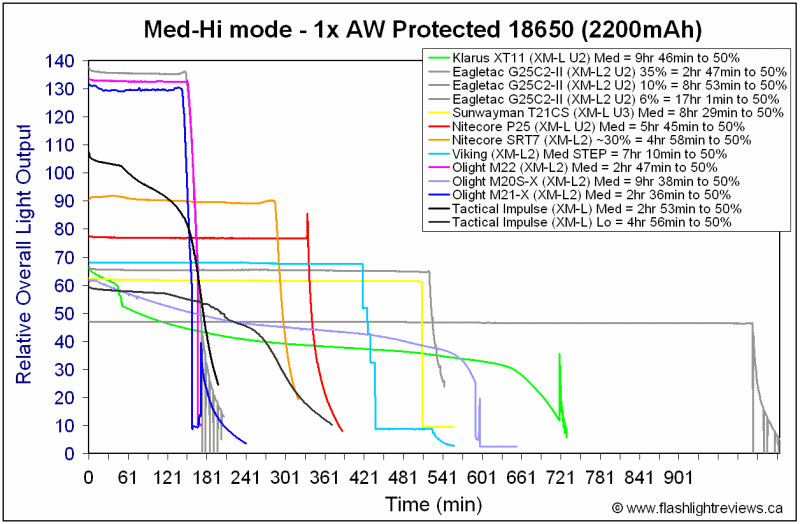
On Max, the LE-1 performs as you would expect for a partially-regulated 18650 light.
On the Lo/Med modes though, there is a clear drop-off in efficiency compared to most of the competition. It is thus disappointing that the light suffers from both visible PWM flicker and lower efficiency on Lo/Med. :sigh: However, even if runtimes are lower in relative terms, they may still be acceptable to you in absolute terms (i.e., they do match the reported specs).
How about 2x18650?
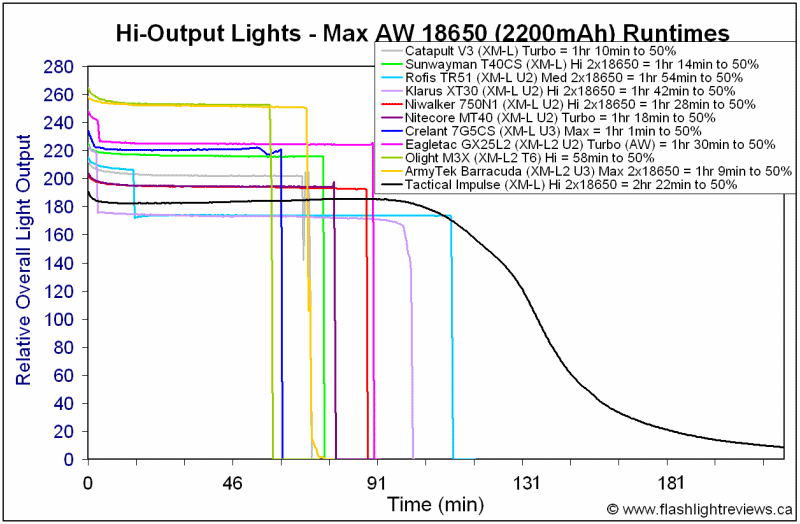
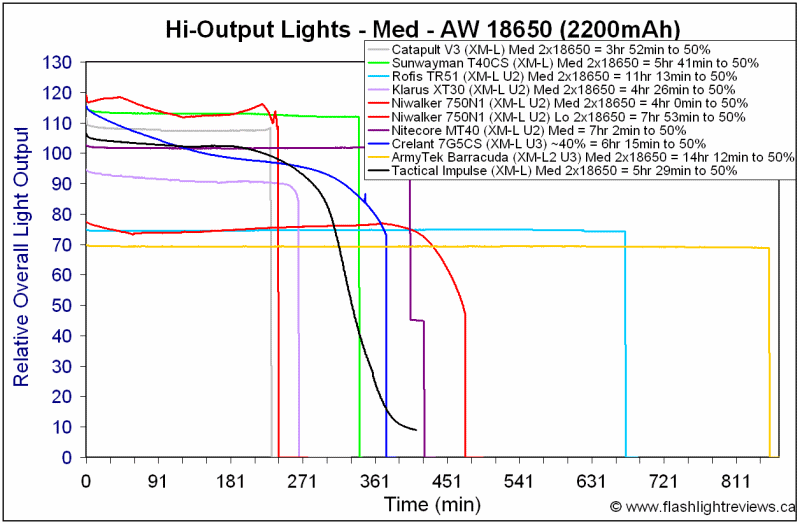
Again, the LE-1 performs as you would expect on Max (i.e., comparable for this class).
On Med, I am happy to report improved relative performance (i.e., more in keeping with what I would have expected). I haven't tested the Lo mode, but these results are encouraging for those of you who plan to use the light in 2x18650 configuration.
Potential Issues
The LE-1 is officially a 1x or 2x 18650 Li-ion only light. While 2x primary CR123A cells will work in the light, they are likely to produce unstable output on Hi (see my post #15 below). I would thus consider CR123A use for "backup" purposes only. However, the LE-1 does come with an in-light charging solution, compatible with both 1x and 2x 18650 configurations.
Light has visible low-frequency PWM on its Lo/Med modes, of 125 Hz.
Relative efficiency on Lo/Med modes is lower than other lights in this class, on 1x18650. Performance on Hi seems reasonable, as do all levels on 2x sources.
Light is longer and heavier in 1x18650 configuration than most lights in this class.
Light lacks a true Lo mode.
You need to buy the charging cradle or smart holster to be able to turn the mode memory feature on/off .
Holster only fits the light in the 1x18650 configuration (i.e., traffic wand and extender options won't work with the holster).
There is standby drain when fully connected, but I unsure of its typical level. You can lock out the light (and presumably break this current) by a quarter turn of the tailcap.
Strobe is on the main sequence with the constant output modes.
Light uses a battery carrier in the base 1x18650 configuration. Although the carrier seems reasonably well made, there are exposed connecting wires inside the carrier, and long-term stability is unclear. I recommend battery changes be performed carefully, in proper lighting to ensure no accidental damage to the carrier. Recharging the cell in-light, using the optional charging cradle/dock, may be the best option for heavy users.
The charging cradle appears well built, and charged the in-light 18650 in record time. However, the secondary bay for a stand-alone 18650 took longer, and charged the cell to an unacceptably high ~4.25V resting voltage. I recommend you charge batteries inside the light, using the in-light charging dock bay.
Light package lacks replacement o-rings, and the unit was shipped without lube on the threads or o-rings.
Preliminary Observations
This has been a massive review - I recommend you scroll back up to review specific features or accessories that come with the light (i.e., I'm not going to repeat it all here).
Although there is a fairly long list of potential concerns outlined above, part of that simply reflects the extensive array of optional accessories available for the light. Overall, the LE-1 strikes me as a quality product. A lot of care and attention has clearly gone into its design, and it is quite versatile with all the optional accessories. Physically, the light seems reasonably solid in both the base and extended forms. I can definitely see the appeal of many of its features for those in the law enforcement/first responder world.
That said, I am personally disappointed by some aspects of the circuit performance - specifically, the visible low-frequency PWM on the Lo/Med modes, and the drop-off in relative efficiency on these modes in 1x18650 configuration. The PWM may not be an issue for you (i.e., there is a lot of variation in how noticeable/distracting PWM is to different individuals). And the performance of the light does accurately match the reported specs (i.e., you know what you getting when you buy it). I could see the feature set and accessories out-weighing these concerns for many, but I would still urge Tactical Impulse to work to improve the circuit functioning on Lo/Med.
Aside from some concerns about the long-term stability of the battery carrier, most of my other suggestions are relatively minor (i.e., include extra o-rings in the package, and lube the o-rings/threads properly at the factory). I do like the detailed and clear manuals, and accurate performance specs. And I like the stability of the holster and charging cradle dock for supporting the light (although see my earlier comments about the stand-alone charging bay). An additional holster design for the extended forms of the light would also be good. I am also glad to see the magnetic charging solution, which removes any risk of accidentally shorting the external charging contacts – a nice design.
Beam profile is good, well suited to general-purpose duty tasks with the range of output modes (although I would personally like a lower Lo). That said, premium cool white and neutral white XM-L2 emitter options would also be nice, as well as a good diffuser.
All told, this is an interesting initial foray into the crowded tactical flashlight space. By launching with accessories specifically designed for LEOs/first responders, I can see the potential for market uptake. With a few refinements, Tactical Impulse should be a competitive choice for these communities, as well as the general purpose user.
----
LE-1 and accessories were provided by Tactical Impulse for this review.



The LE-1 is the first light from Tactical Impulse, a new manufacturer geared toward law enforcement officers (LEOs) and first responders. The LE-1 comes with a wide range of accessories suited to these markets. These can purchased individually, or bought together with the light in the kit form – which I have here to review.
I will start this review with the base light, and add the additional kit accessories as we go along. This is going to be a long one, so sit back and make yourself comfy …

Manufacturer Reported Specifications:
(note: as always, these are simply what the manufacturer provides – scroll down to see my actual testing results).
- LED: Cree XM-L
- Lumen Output – HIGH: 595 lm (100%), MEDIUM: 269 lm (50%), LOW: 115 lm (20%),
STROBE (100%) - FL-1 Runtimes (1x Tactical Impulse 3100mAh) – HIGH: 2.1 hrs., MED: 4.5 hrs., LOW: 12.2 hrs.
- FL-1 Runtimes (2x Tactical Impulse 3100mAh) – HIGH: 3.4 hrs., MED: 8.4 hrs., LOW: 22.1 hrs.
- Beam Distance/Intensity: HIGH: 226m (12060cd), MEDIUM: 171m (6080cd), LO: 110m (2593cd)
- Construction Material: Aluminum (body), Stainless Steel (bezel)
- Finish: Anodized Type III
- Reflector: Faceted Aluminum
- Lens: 1/16" Impact Resistant Glass, anti-reflective coating
- Battery Type: 18650 3100 mAh Rechargeable Li-ion
- Length: 8.38"
- Weight w/Battery: 11.6 oz.
- Bezel Diameter: 2.13"
- Water Resistance: IPX8 (Submersible)
- Impact Rating: 2 M
- Warranty: Limited Lifetime
- Package Includes LE-1 flashlight, Tactical Impulse 3100mAh Li-ion battery, user guide
- MSRP: $125
- Optional accessories: Size & Life Extension Pack, Traffic Baton, LE-1 Cradle Charger, LE-1 Smart Holster, single battery charger, extra Tactical Impulse 3100mAh Li-ion batteries.
- LE-1 Kit version includes: Size & Life Extension Pack, Traffic Baton, LE-1 Cradle Charger.
- LE-1 Kit version MSRP: $210


For LE-1 comes with what it promises – inside the box you get the light, a Tactical Impulse 18650 3100mAh Li-ion battery, and user guide. Oddly, there are no extra o-rings provided in the package.




From left to right: Tactical Impulse Protected 3100mAh 18650, LE-1; Crelant 7G6CS; XENO G42; Thrunite Scorpion V2; Eagletac GX25L2.
All dimensions directly measured, and given with no batteries installed:
Tactical Impulse LE-1: Weight: 282.2g, Length: 208mm, Width (bezel): 52.0mm
ArmyTek Viking V2.5: Weight: 159.8g, Length: 153mm, Width (bezel): 39.5mm
Eagletac G25C2-II (stock): Weight 141.0g, Length: 150.6mm, Width: 39.6mm
Eagletac TX25C2: Weight 93.6g, Length: 120.4mm, Width (bezel): 31.6mm
Olight M21-X: Weight: 125.5g, Length: 144.5mm, Width: 40.3mm (head)
Olight M22: Weight: 148.4g, Length: 144.8mm, Width: 41.2mm (bezel)
Nitecore SRT7: Weight: 172.4g, Length: 158mm, Width (bezel): 40.0m
The LE-1 is longer and heavier than your typical 1x18650 tactical flashlight. The reasons for this will become obvious once we "pop the hood" and look inside …






As you can see above, the LE-1 uses a battery carrier for the 18650 cell. This clearly adds to length – I will discuss the carrier specifically a bit later.
Overall, the physical build of the light seems good. Anodizing is of matte finish, and is of good quality (no chips on my sample, and manufacture reports type III). Body labels are very bright and clear, sharp against the black background.
The light doesn't really have knurling per se – instead, there is a checkered pattern across the body handle and in bands on the tailcap, similar to some Thrunite and Niwalker lights. It is not very aggressive on the LE-1, but does help with grip. Note there is no clip, grip ring or lanyard included with the light (although there are lanyard attachment points in the tailcap).
Screw threads are traditional triangular cut, and seem of good quality (anodized at the tailcap for lock-out). :thumbsup: There are double o-rings in the head, single in the tail. Note there was an almost complete absence of lube on my sample, which contributed to noisy threading.
I will discuss the build of the battery carrier below, but there are a series of contact points at both ends that connect to the head/tailcap (i.e., 2 sets of contacts in the head, 3 sets in the tail). The reasons for these will become obvious when I discuss the user interface and optional accessories.
There are two electronic switches on the light, one in the head and one on the tailcap. Both have similar function, and can control the light independently. Both are dual-stage (i.e, partial press to reach the first resistance point, press further to reach the second point with a definite click). Scroll down for a discussion of the interface.
There are two shiny metal bands at the base of the head. These are used with the optional charging cradle dock to charge a 18650 inside the light. They are also used by the duty belt holster, to inactivate the light while holstered. I am happy to report that I was unable to detect an open voltage across the bands (i.e., there is no apparent risk of shorting your cells).



Reflector is heavily textured (i.e., heavy orange peel). XM-L emitter (Cool White tint) was well centered on my sample. There is a crenelated stainless steel bezel and visible anti-glare coating on the lens. See beamshots later in this review.
Battery Carrier







The battery carrier is certainly unique on this light. In addition to external contacts mentioned previously, there are springs at both the negative and positive terminal areas. This means that flat-top cells can be used, and the 3100mAh protected Tactical Impulse batteries fit fine. One comment here – be careful when inserting a button-top battery into the carrier, as you don't want to bend to the top spring.
As previously mentioned, the LE-1 can charge an 18650 cells inside the light. Combined with the dual switch design (and support for additional accessories), this requires a more complicated carrier wiring. As you can see above, there are two exposed wires that run the length of the inside of the carrier. Be careful not to damage these wires, and always make sure your 18650 cells are fully insulated in their plastic wrap (i.e., you wouldn't want a risk of shorting a contact to these internal wires.
There are a number of accessories available for the light. I am going to start below with the special purpose holster
Smart Holster










The holster is unlike anything I've seen before. It has a hard shell plastic body, that securely holds the light at the neck region. There is an adjustable belt height control, secured by two screws on either side. This holster is clearly designed for a LEOs duty belt.
There is an opening at the base, allowing you to reach the tail switch – but the light cannot be activated when it is in the holster. In fact, if on, the light shuts offs when securely holstered, and can't be re-activated until it is removed. This is due to the magnetic contact near the head of the holster (i.e., what makes it a "smart" holster).
Note also the holster (or the optional charging cradle described below) does allow you to program the memory feature of the light. By default, mode memory is turned off (i.e., light always activates in max). To turn the memory feature On, you have to press and hold the main power switch for 5 secs when holstered/cradled. The light will flash to let you know memory programming has been set. You must use the holster to set/reset this feature.
Charging Cradle/Dock









The charging dock is a significant unit, and can be mounted horizontally or vertically. It has a holding ring similar in design to the holster, but with two contacts to allow in-light charging of the 18650 cell. As with the holster, you can use this dock to program memory on/off. There is a second charging bay for a spare cell.
The connector for the AC or AC/DC adapter is robust, with a metal screw cover. It holds securely to the base unit, so you don't need to worry about accidental disconnection. :thumbsup:
The two charging ports are reported to be independent, and I have verified this in my testing. However, they do not perform equivalently, as explained below.
Both charging bays have LEDs that light up full green when the slot is empty and power is supplied to the unit. When you plug in a depleted battery in the LE-1 for the in-light bay, or separately in the secondary battery bay, the charger LEDs turn full red. Over the charge cycle though, the in-light bay LED will gradually turn amber and then green (i.e., the green LED starts to come on as the light charges, and gradually replaces the red LED). The secondary bay doesn't show this pattern – the LED remains constant red until it switches over to solid green.
Charging time is also different between the bays. With a 2200mAh 18650 cell, the in-light charging port LED went green after 2hr 30 mins, with a cell resting voltage of ~4.17V. This is a bit low for a fully charged cell, but that's better for the long-term cell health anyway.
The secondary bay is slower to charge a cell – it took just under 4 hours to fully charge the same 2200mAh 18650. However, the resting voltage of the cell in this bay was ~4.25V.
 That is higher than I would like to see for a resting voltage, since it means the bay charged the cell to beyond the max specs near the end of its cycle. This will shorten the lifespan of a 18650 cell.
That is higher than I would like to see for a resting voltage, since it means the bay charged the cell to beyond the max specs near the end of its cycle. This will shorten the lifespan of a 18650 cell.I am unable to measure the current charging characteristics of the in-light charger, but I can confirm that the secondary bay charger doesn't completely terminate when the light goes green – instead, it drops down to a constant 4uA current. This is low enough to not cause a problem (i.e., this is not a "trickle charge", which would be a much higher mA current). Nevertheless, I don't recommend you ever leave a cell plugged into any charger once fully charged.
Battery Extender







From left to right: Tactical Impulse Protected 3100mAh 18650, LE-1 (with extra 18650 extender); Thrunite Catapult V3; Crelant 7G5CS; Klarus XT-30; Eagletac GX25L2.
All dimensions directly measured, and given with no batteries installed:
Tactical Impulse LE-1: Weight: 334.2g, Length: 270mm, Width (bezel): 52.0mm
ArmyTek Barracuda: Weight 400.8g, Length 264mm, Width (bezel): 64.0mm
Crelant 7G5CS: Weight: 334.5g, Length: 247mm Width (bezel): 64.0mm
Eagletac GX25L2: Weight: 198.3g (with battery pack: 290.1g), Length: 224mm, Width (bezel): 39.5mm
Eagletac GX25L2 Turbo: Weight: 320.7g (with battery pack: 412.5g), Length: 251mm, Width (bezel): 62.0mm
Klarus XT30: Weight: 283.1g, Length: 247mm, Width (bezel): 58.0mm
Niwalker 750N1: Weight: 408.0g, Length: 269mm, Width (bezel): 58.6mm
Olight M3X with Extender: Weight 277.8g, Length 244mm, Width (bezel): 62.3mm
Thrunite Catapult V3: Weight: 434.8g, Length: 254mm, Width (bezel) 58.0mm, Width (tailcap) 35.1mm.
To install the extender unit, remove the tailcap switch of the LE-1. With the battery extender unit in place, you can insert a second 18650 cell to double the runtime of the light. Note the extender doesn't use a carrier – instead, simply place the second cell in the same orientation as the first (i.e., positive terminal toward the head)
The extender unit has a flat base with a spring. No tail switch is now possible, due to the design – you control the light solely by the head switch now.
Note the extender cannot be used with the LE-1 duty holster, due to the closed-in base. This holster design was apparently developed to prevent the light from getting accidentally snagged on a seat belt, or other restraint.
An interesting feature to the design is that the extender battery actually runs parallel to the primary carrier cell (i.e., they are NOT in series). This means that you can run the light with only battery in the extender portion (i.e., nothing in the main carrier). It's an interesting configuration for someone looking to balance the weight, or swap cells by swapping extenders, etc.
Traffic wand










From left to right: Tactical Impulse Protected 3100mAh 18650, LE-1 (with red light kit); Thrunite Catapult V3; Crelant 7G5CS; Klarus XT-30; Eagletac GX25L2.
The traffic wand is also pretty unique in my experience. It screws on to the base of the LE-1, once you remove the tailcap, and draws power from the main cell in the LE-1. It is composed of a series of red rods in an acrylic base, with red LEDs at the base of the switch unit.
There is a control switch on the Traffic wand – click (press release) to turn on in solid red. Click again for a slow signaling red strobe/beacon. Click a third time for off.
Note the main LE-1 switch can still function independently from the traffic wand accessory (i.e., you can have both on at the same time). Now you can probably see why there is a battery carrier and so many connection points.
The LE-1 won't fit into the holster with the traffic wand assembly attached.
User Interface
Basic user interface for the LE-1 is controlled by either electronic switch (i.e., the tail switch and head switch function exactly the same way).
Both switches are two-stage - press-and-hold to the first resistance point for momentary on (i.e., release to turn off), or press further (i.e., click) for constant locked on.
There are three constant output levels and a strobe controlled by soft-pressing either switch (i.e., a partial press and release). From on, mode sequence is Hi (100%) > Med (50%) > Lo (20%) > Strobe, in a repeating loop.
In default form, there is no mode memory (i.e., always comes on in Hi). This can reprogrammed with memory turned on using the accessory holster or charging dock. To turn the memory feature on, press and hold the main power switch for 5 secs when holstered/cradled. The light will flash to let you know memory programming has been set. You must use the holster to set/reset this feature.
Screw threads are anodized, so you can lock out the light by a twist of the tailcap. Note that light will shut-off automatically if holstered or cradled, in the supplied accessories.
Video:
For information on the LE-1 and all its accessories, please see my rather lengthy video overview:
Video was recorded in 720p, but YouTube typically defaults to 360p. Once the video is running, you can click on the configuration settings icon and select the higher 480p to 720p options. You can also run full-screen.
As with all my videos, I recommend you have annotations turned on. I commonly update the commentary with additional information or clarifications before publicly releasing the video.
PWM/Strobe
As with other lights that offer dual electronic switches, the LE-1 uses Pulse Width Modulation (PWM) for its Lo/Med modes. Unfortunately the LE-1 uses a visually detectable frequency.
PWM Lo

PWM Med

Honestly, it's been awhile since I've seen such a low frequency – 125 Hz is VERY easy to detect visually. :shakehead
I've not sure why they had to opt for such a low PMM frequency. But that being said, I didn't find the LE-1 as distracting as I expected it to be, given this frequency. I suspect the reason for this is the relatively high Lo/Med output modes – 20% and 50% max output are both quite bright. I have found that low freq PWM is most annoying at much lower duty cycles, for some reason.
To give you a comparable, the original Olight M30 (with dual switches) had ~100 Hz PWM. I found it unacceptable at its Lo mode, which was ~2% max output. However, it's Med mode (which was ~20%, the same as the Lo mode here on the LE-1) was much more tolerable. But it is still quite visible, so I encourage Tactical Impulse to raise the 125 Hz frequency significantly.
Strobe:

Strobe was a fast "tactical" strobe, of 10 Hz frequency.
Standby Current
Because of the dual electronic switches, the LE-1 will always be drawing a small amount of power when fully connected. It is hard to get a clear reading on this light, due to the the complex wiring arrangement. I have tried to get readings with the extender in place, to simplify the connection, but I get inconsistent results using my DMM. For example, on 2x18650, I measure ~170uA on my DMM's uA scale, but ~8.5mA on my mA scale (both using the uAmA port). With a single 18650 with extender in place, I get ~850uA or ~3.3mA. :thinking: Neither of these sets of results are consistent with each other, given the parallel cell arrangement. As a result, I am not clear as to what the typical standby drain is.
If you are concerned, you can lock out the light by twisting the tailcap a quarter turn. This physically locks out the light, to prevent accidental activation (and seems to remove any drain).
Beamshots:
For white-wall beamshots below, all lights are on Max output on an AW protected 18650 battery. Lights are about ~0.75 meter from a white wall (with the camera ~1.25 meters back from the wall). Automatic white balance on the camera, to minimize tint differences (but there may still be some variation).
















The heavily textured reflector smooths out the hotspot quite bit, and overall spillbeam width is reasonable for the class. Note that I found the tint to be a bit on the purplish-end of cool white on my LE-1 sample (of course, YMMV).
Testing Method:
All my output numbers are relative for my home-made light box setup, a la Quickbeam's flashlightreviews.com method. You can directly compare all my relative output values from different reviews - i.e. an output value of "10" in one graph is the same as "10" in another. All runtimes are done under a cooling fan, except for any extended run Lo/Min modes (i.e. >12 hours) which are done without cooling.
I have devised a method for converting my lightbox relative output values (ROV) to estimated Lumens. See my How to convert Selfbuilt's Lightbox values to Lumens thread for more info.
Throw/Output Summary Chart:
My summary tables are reported in a manner consistent with the ANSI FL-1 standard for flashlight testing. Please see http://www.flashlightreviews.ca/FL1.htm for a discussion, and a description of all the terms used in these tables. Effective July 2012, I have updated all my Peak Intensity/Beam Distance measures with a NIST-certified Extech EA31 lightmeter (orange highlights).


Max output is a bit lower than most recent lights in the 1x18650 class, but consistent with Tactical Impulse's reported specs. There was absolutely no difference in output between 1x18650 and 2x18650.
Note that my directly measured beam intensity was higher than their report ANSI FL-1 spec.
Let's see how output compares across the various levels:

As you can see, my results are fairly consistent across the board with their ANSI FL-1 lumens specs.
Output/Runtime Graphs:
Let's start with a comparison of the Tactical Impulse 3100mAh 18650 cells, compared to my standard AW 2200mAh protected cells.


As expected, the 3100mAh cells have proportionately longer runtimes than 2200mAh cells. The LE-1 is partially regulated - after an initial dip, the light maintains flat regulation for a good portion of the run, eventually falling out of regulation as the batteries drain.
Runtimes seems very consistent with reported ANSI FL-1 specs, on the supplied 3100mAh cells. Note I report runtimes as time to 50%, but ANSI FL-1 standard is time to 10%.
How does the LE-1 stack up to the competition? Let's start with the 1x18650 configuration:
Note: Unless otherwise stated, all my 18650 runtimes below are based on AW 2200mAh Protected 18650 cells.


On Max, the LE-1 performs as you would expect for a partially-regulated 18650 light.
On the Lo/Med modes though, there is a clear drop-off in efficiency compared to most of the competition. It is thus disappointing that the light suffers from both visible PWM flicker and lower efficiency on Lo/Med. :sigh: However, even if runtimes are lower in relative terms, they may still be acceptable to you in absolute terms (i.e., they do match the reported specs).
How about 2x18650?


Again, the LE-1 performs as you would expect on Max (i.e., comparable for this class).
On Med, I am happy to report improved relative performance (i.e., more in keeping with what I would have expected). I haven't tested the Lo mode, but these results are encouraging for those of you who plan to use the light in 2x18650 configuration.
Potential Issues
The LE-1 is officially a 1x or 2x 18650 Li-ion only light. While 2x primary CR123A cells will work in the light, they are likely to produce unstable output on Hi (see my post #15 below). I would thus consider CR123A use for "backup" purposes only. However, the LE-1 does come with an in-light charging solution, compatible with both 1x and 2x 18650 configurations.
Light has visible low-frequency PWM on its Lo/Med modes, of 125 Hz.
Relative efficiency on Lo/Med modes is lower than other lights in this class, on 1x18650. Performance on Hi seems reasonable, as do all levels on 2x sources.
Light is longer and heavier in 1x18650 configuration than most lights in this class.
Light lacks a true Lo mode.
You need to buy the charging cradle or smart holster to be able to turn the mode memory feature on/off .
Holster only fits the light in the 1x18650 configuration (i.e., traffic wand and extender options won't work with the holster).
There is standby drain when fully connected, but I unsure of its typical level. You can lock out the light (and presumably break this current) by a quarter turn of the tailcap.
Strobe is on the main sequence with the constant output modes.
Light uses a battery carrier in the base 1x18650 configuration. Although the carrier seems reasonably well made, there are exposed connecting wires inside the carrier, and long-term stability is unclear. I recommend battery changes be performed carefully, in proper lighting to ensure no accidental damage to the carrier. Recharging the cell in-light, using the optional charging cradle/dock, may be the best option for heavy users.
The charging cradle appears well built, and charged the in-light 18650 in record time. However, the secondary bay for a stand-alone 18650 took longer, and charged the cell to an unacceptably high ~4.25V resting voltage. I recommend you charge batteries inside the light, using the in-light charging dock bay.
Light package lacks replacement o-rings, and the unit was shipped without lube on the threads or o-rings.
Preliminary Observations
This has been a massive review - I recommend you scroll back up to review specific features or accessories that come with the light (i.e., I'm not going to repeat it all here).
Although there is a fairly long list of potential concerns outlined above, part of that simply reflects the extensive array of optional accessories available for the light. Overall, the LE-1 strikes me as a quality product. A lot of care and attention has clearly gone into its design, and it is quite versatile with all the optional accessories. Physically, the light seems reasonably solid in both the base and extended forms. I can definitely see the appeal of many of its features for those in the law enforcement/first responder world.
That said, I am personally disappointed by some aspects of the circuit performance - specifically, the visible low-frequency PWM on the Lo/Med modes, and the drop-off in relative efficiency on these modes in 1x18650 configuration. The PWM may not be an issue for you (i.e., there is a lot of variation in how noticeable/distracting PWM is to different individuals). And the performance of the light does accurately match the reported specs (i.e., you know what you getting when you buy it). I could see the feature set and accessories out-weighing these concerns for many, but I would still urge Tactical Impulse to work to improve the circuit functioning on Lo/Med.
Aside from some concerns about the long-term stability of the battery carrier, most of my other suggestions are relatively minor (i.e., include extra o-rings in the package, and lube the o-rings/threads properly at the factory). I do like the detailed and clear manuals, and accurate performance specs. And I like the stability of the holster and charging cradle dock for supporting the light (although see my earlier comments about the stand-alone charging bay). An additional holster design for the extended forms of the light would also be good. I am also glad to see the magnetic charging solution, which removes any risk of accidentally shorting the external charging contacts – a nice design.
Beam profile is good, well suited to general-purpose duty tasks with the range of output modes (although I would personally like a lower Lo). That said, premium cool white and neutral white XM-L2 emitter options would also be nice, as well as a good diffuser.
All told, this is an interesting initial foray into the crowded tactical flashlight space. By launching with accessories specifically designed for LEOs/first responders, I can see the potential for market uptake. With a few refinements, Tactical Impulse should be a competitive choice for these communities, as well as the general purpose user.
----
LE-1 and accessories were provided by Tactical Impulse for this review.
Last edited:


